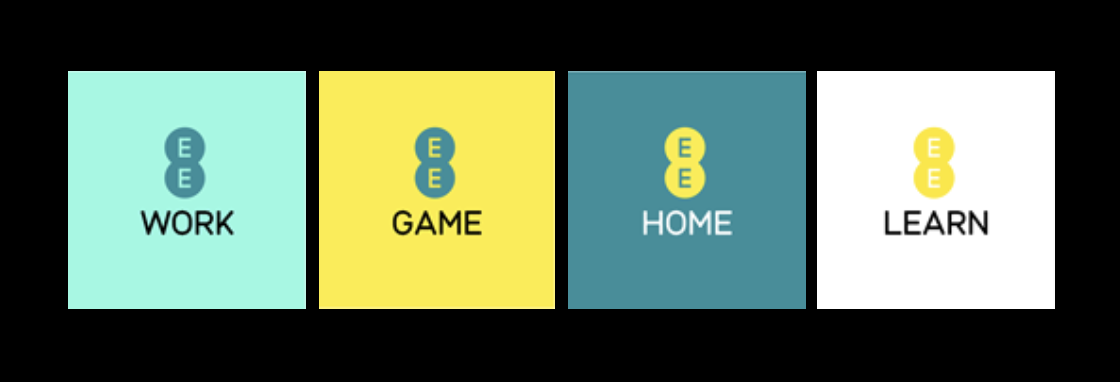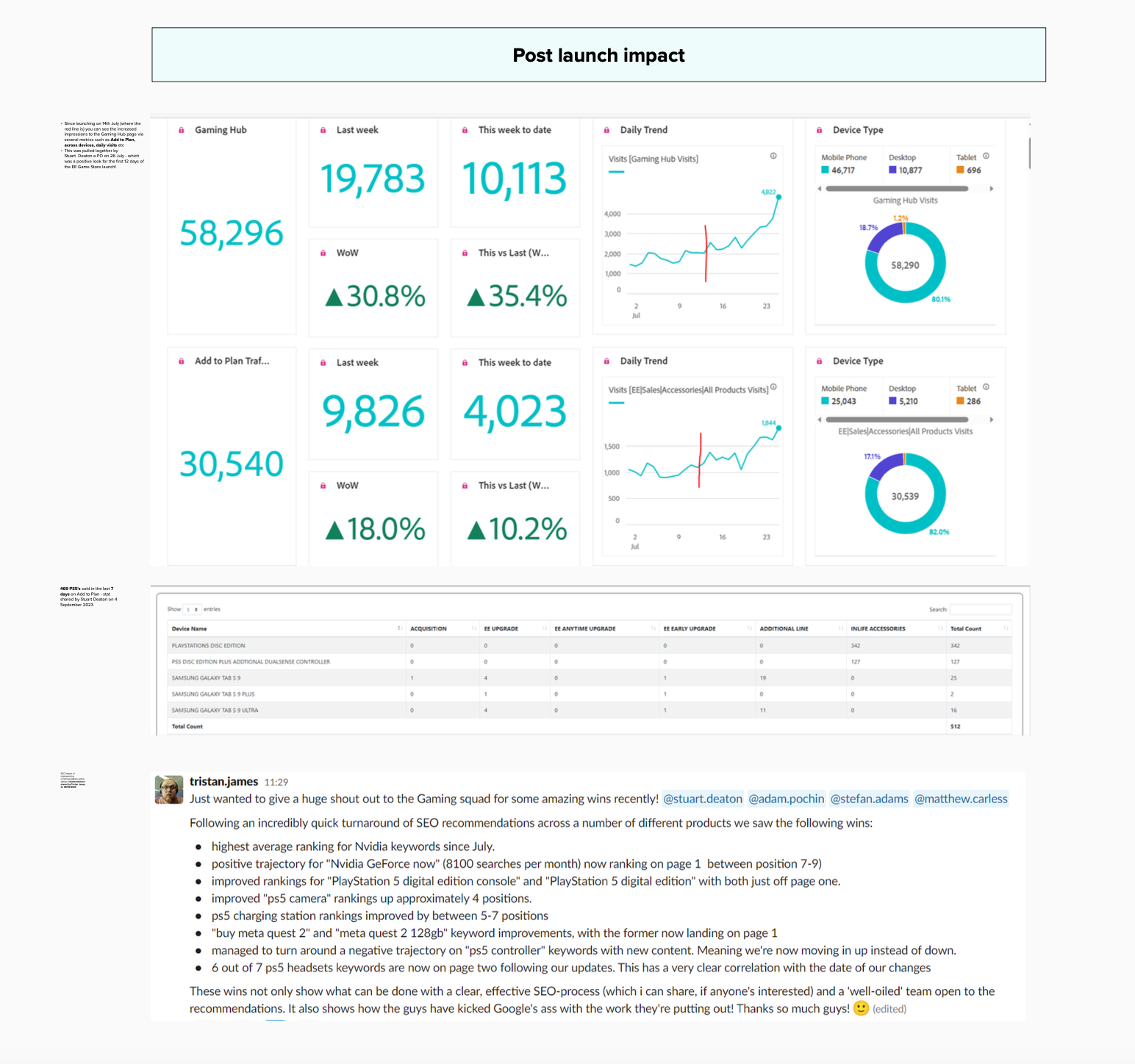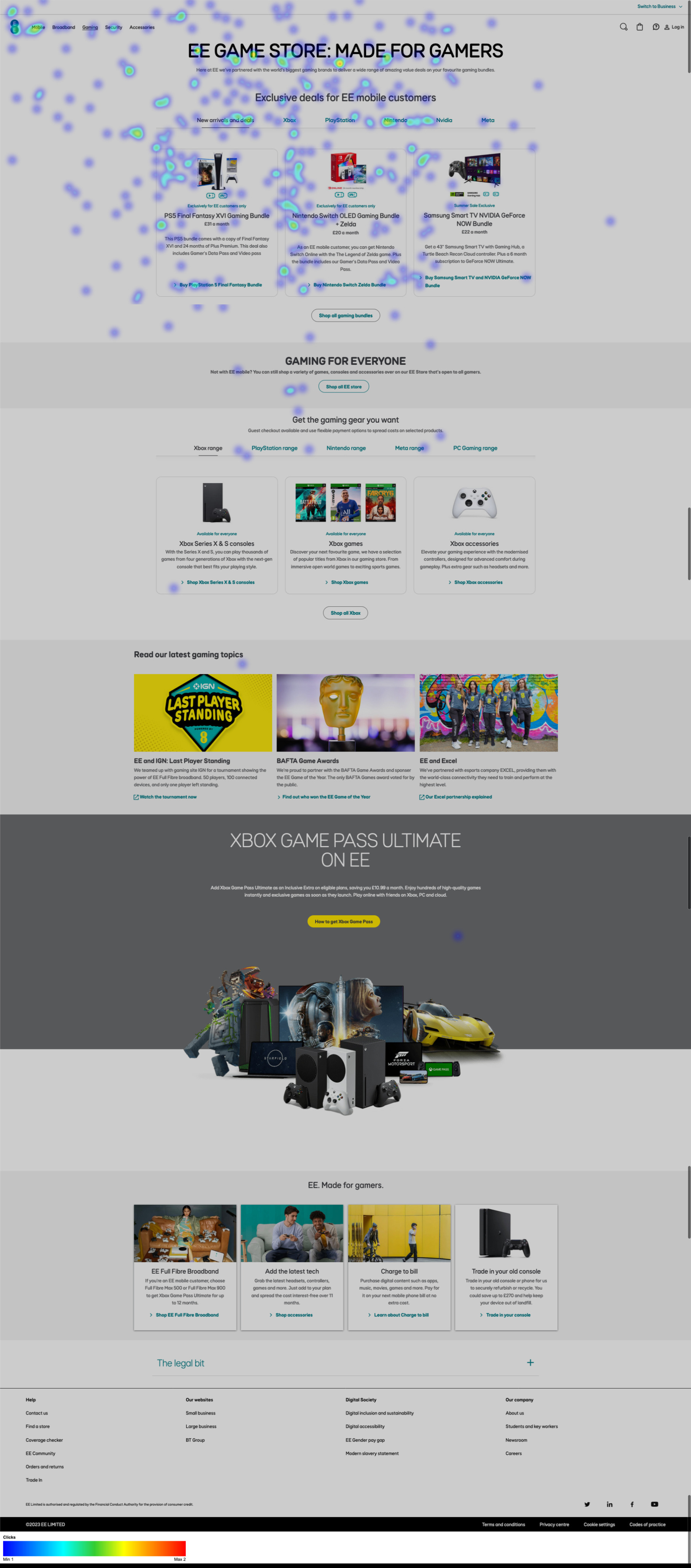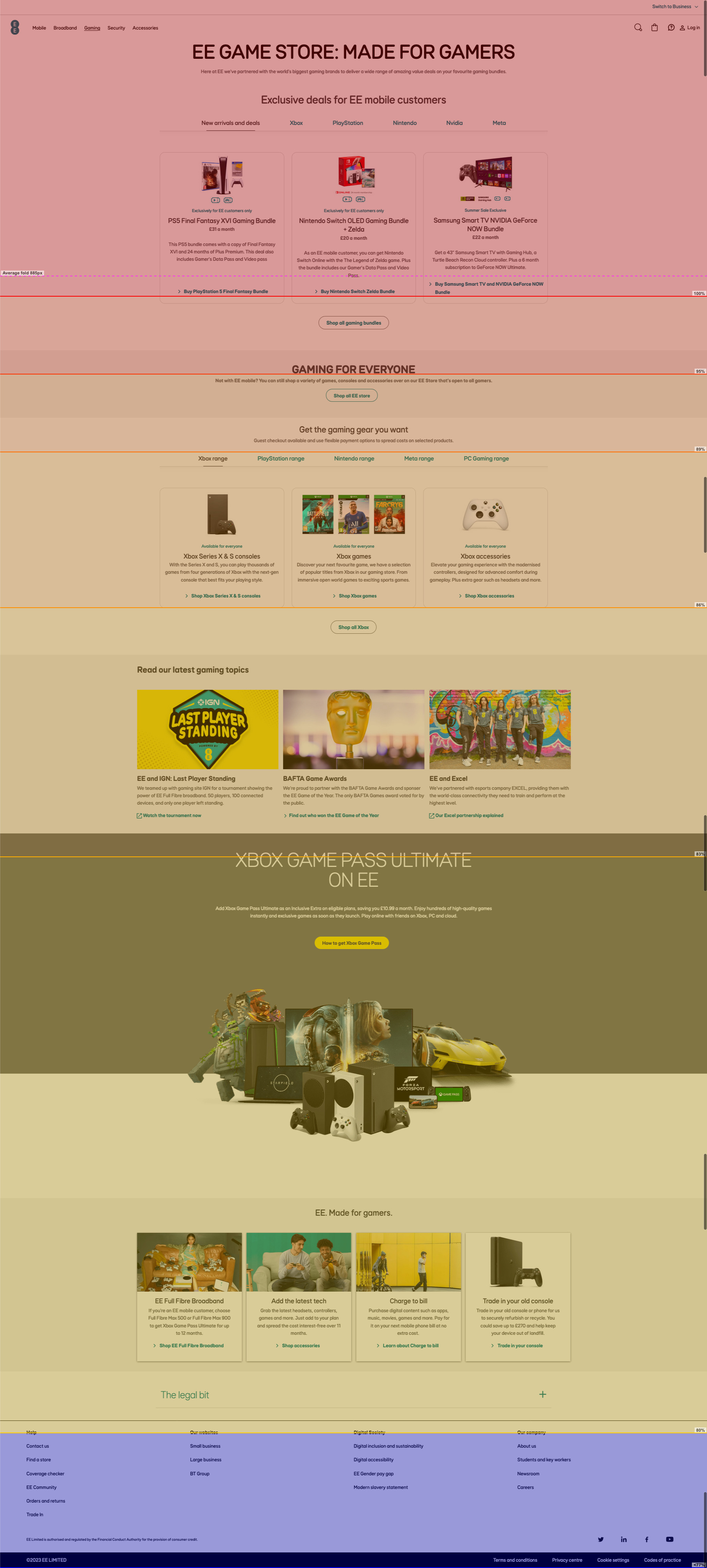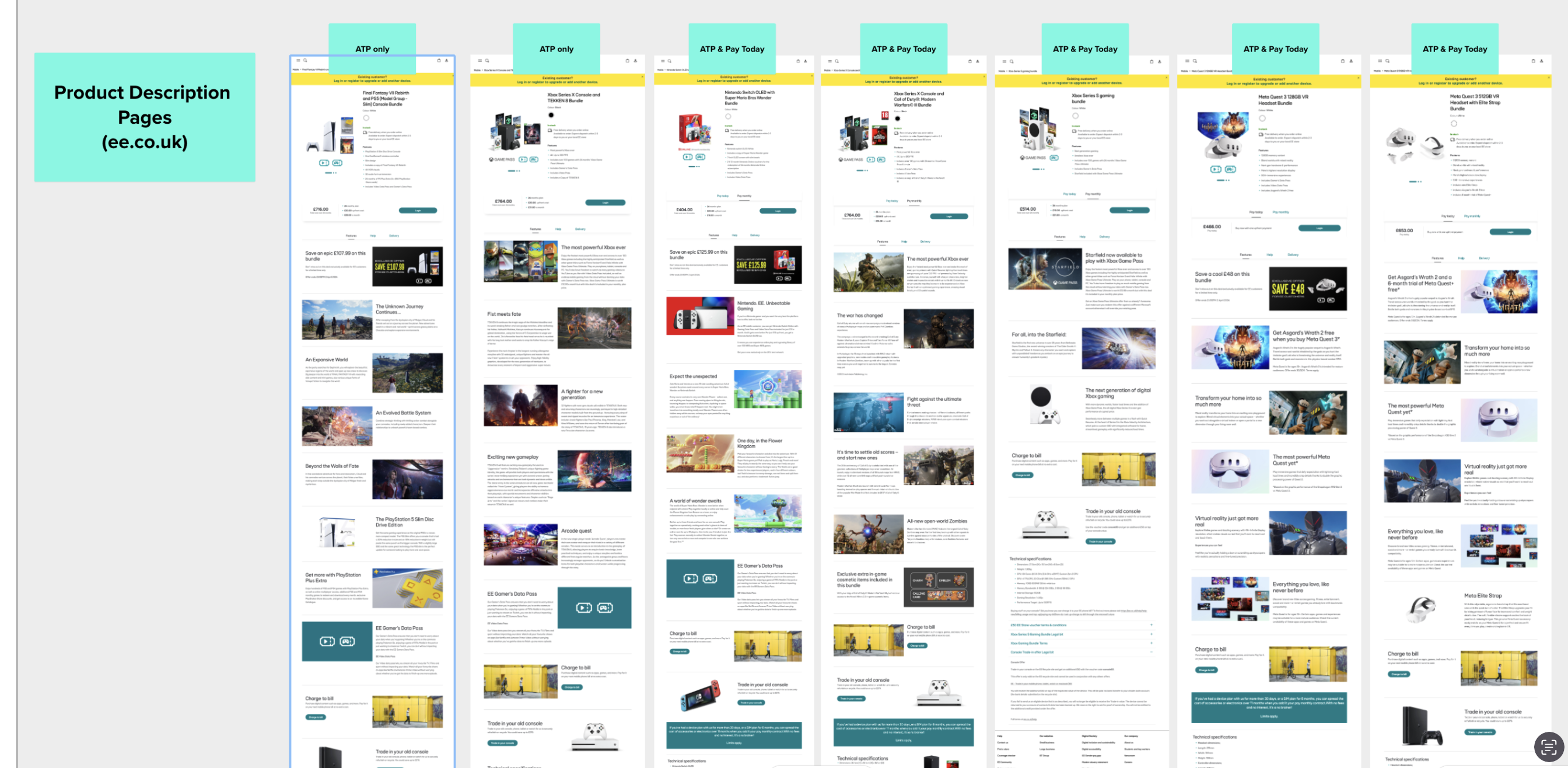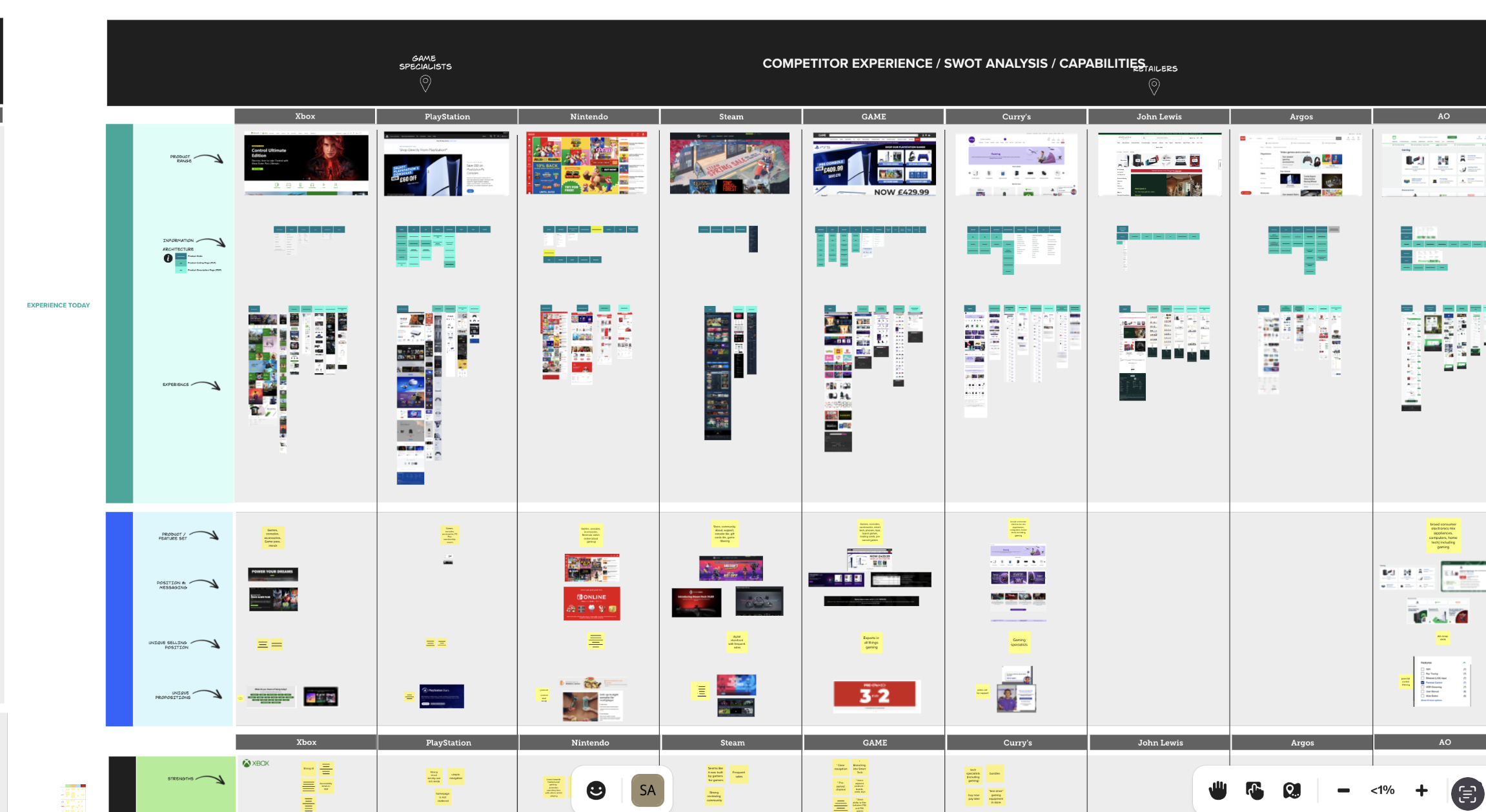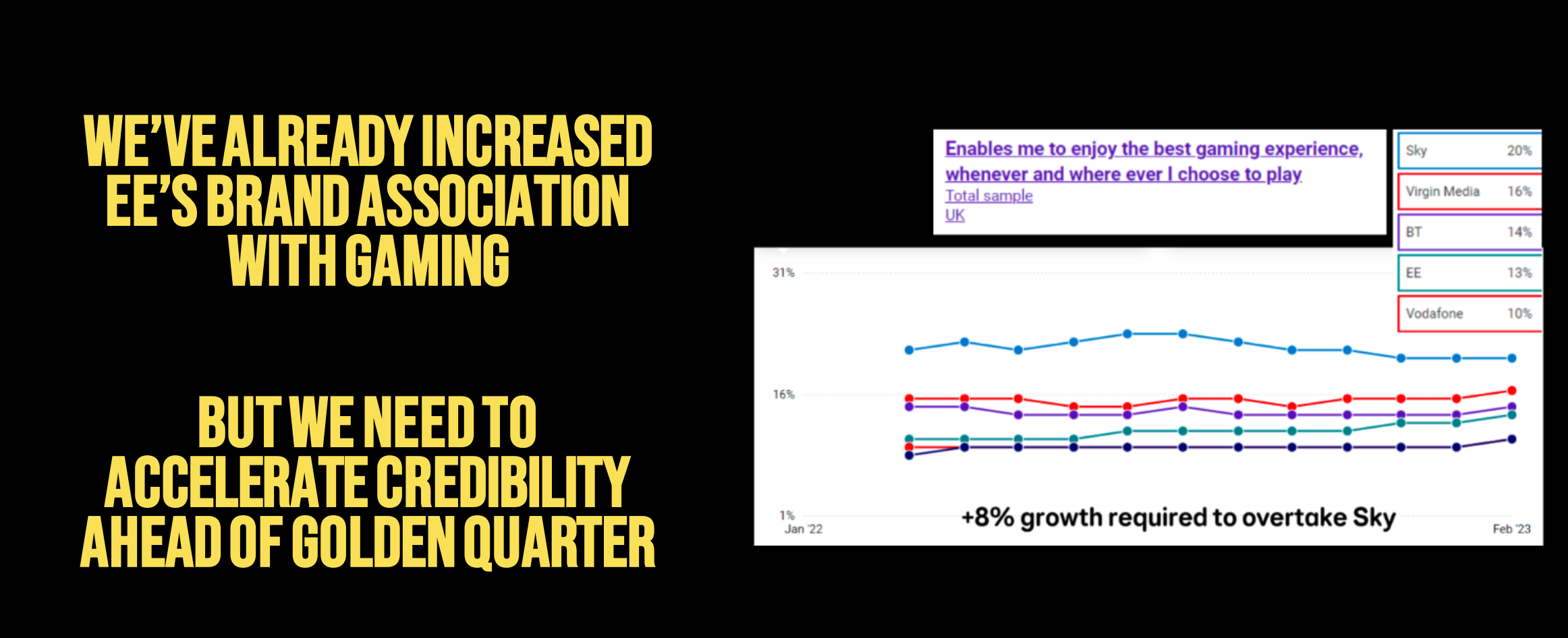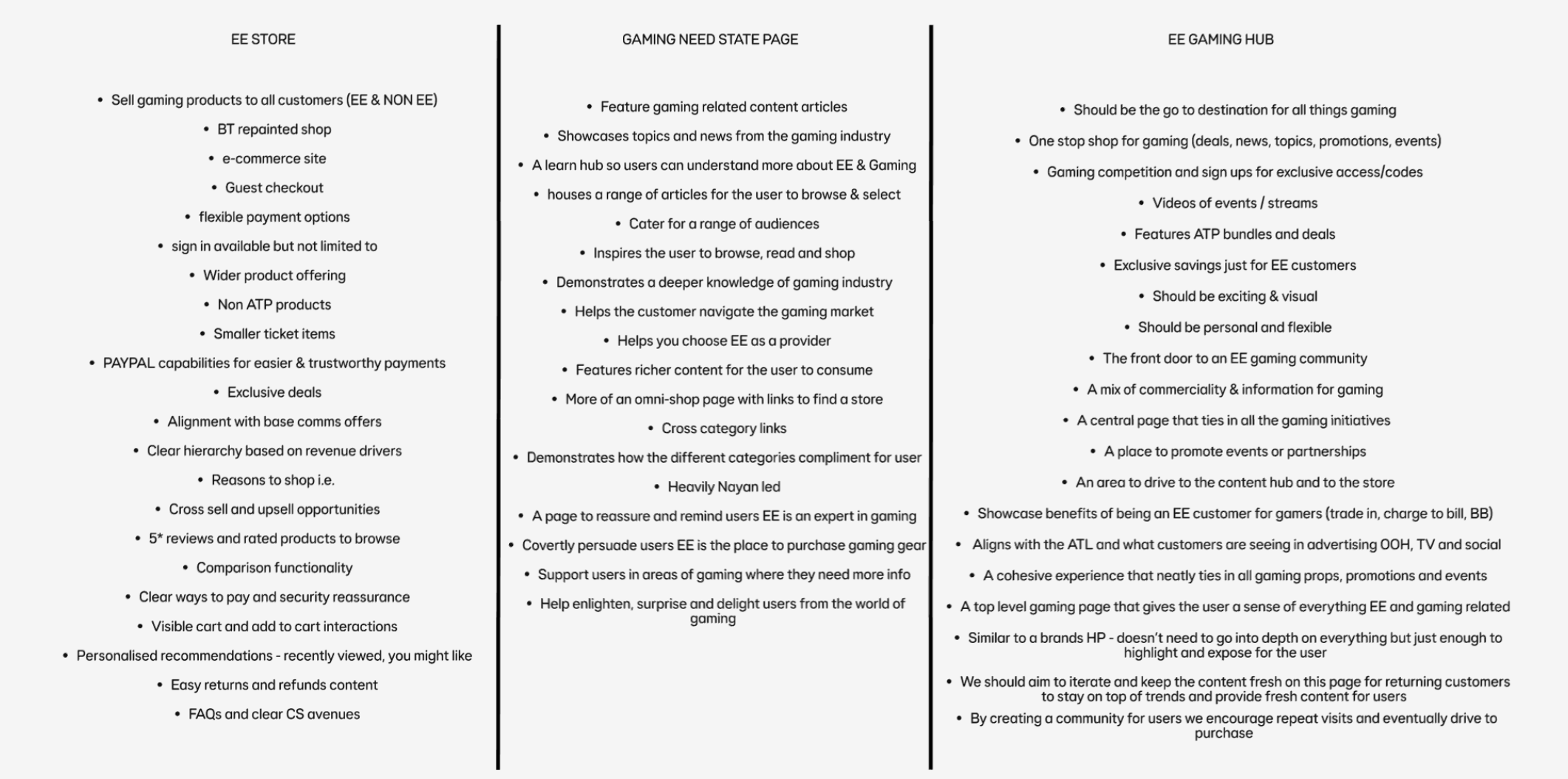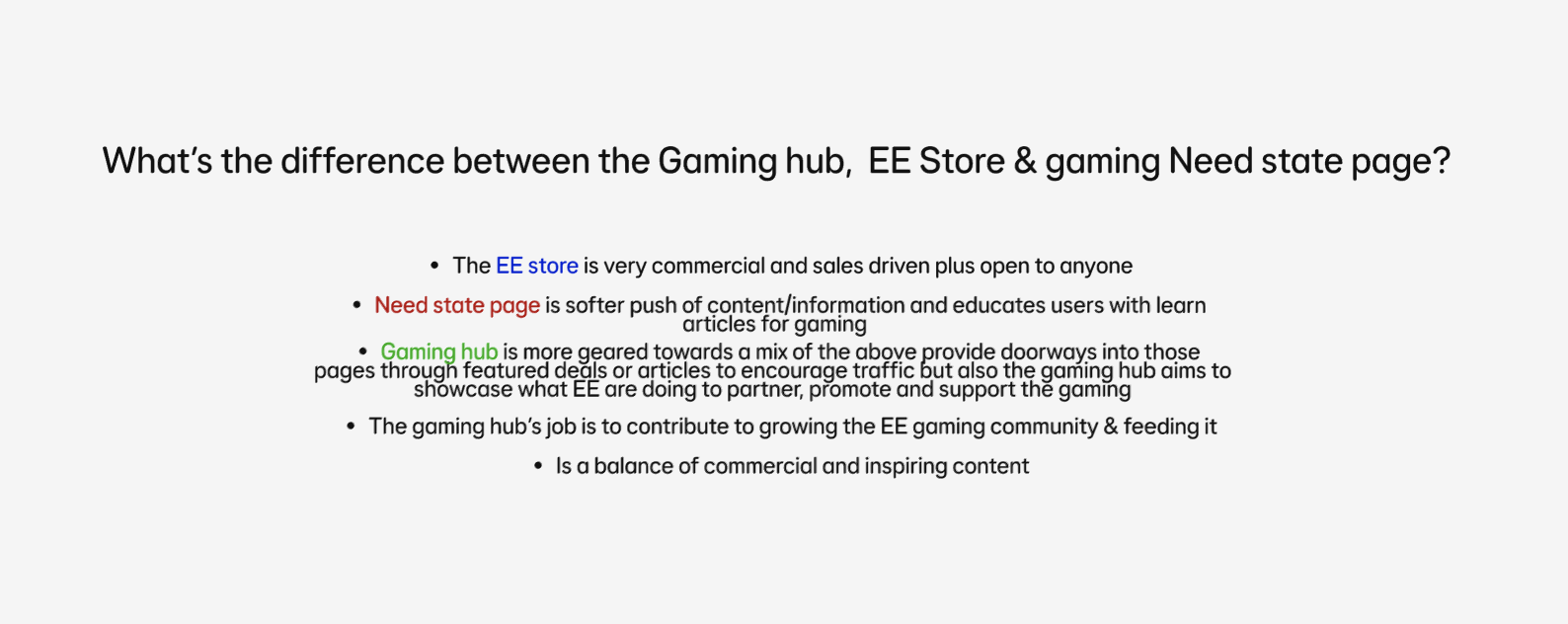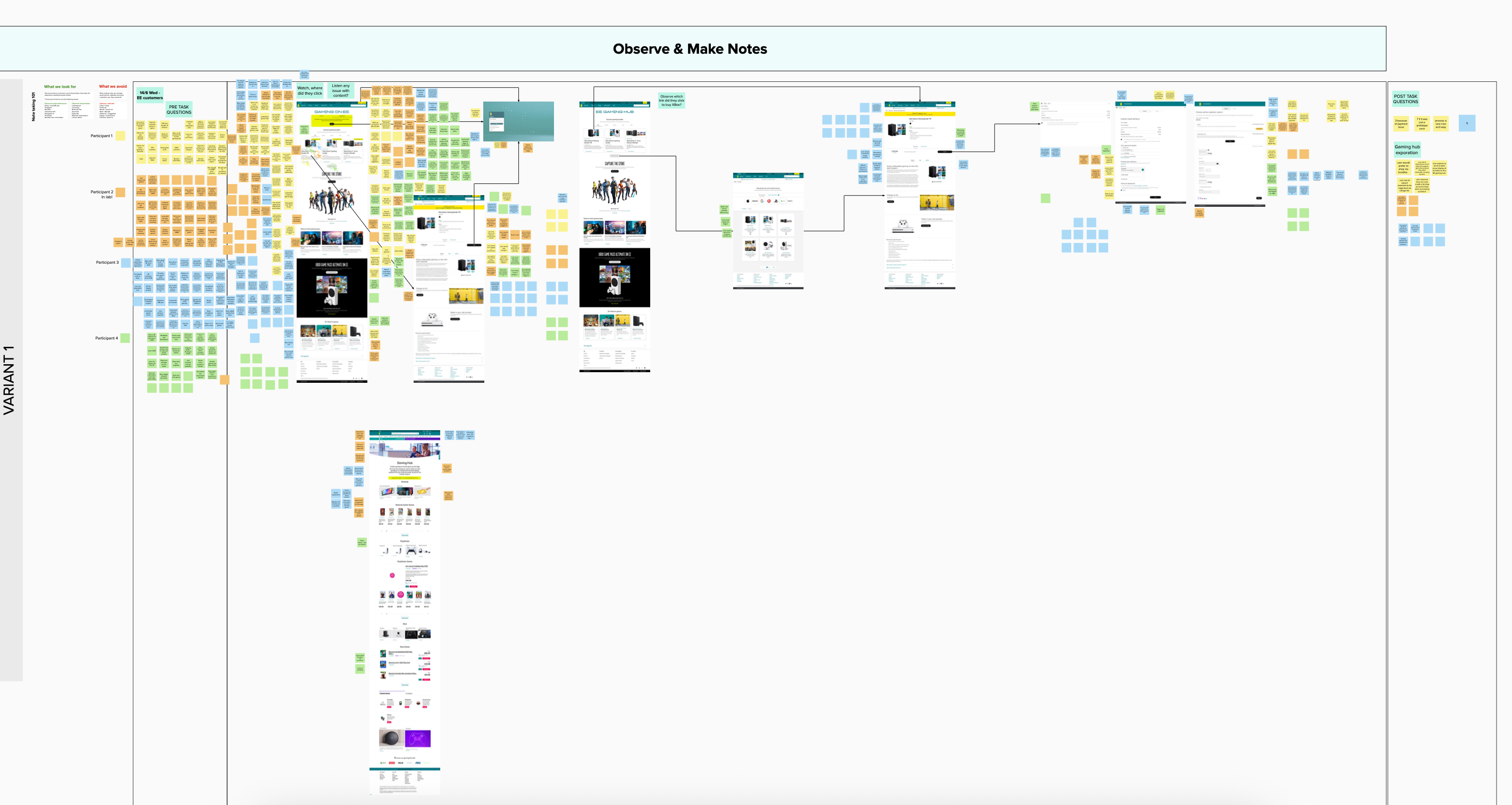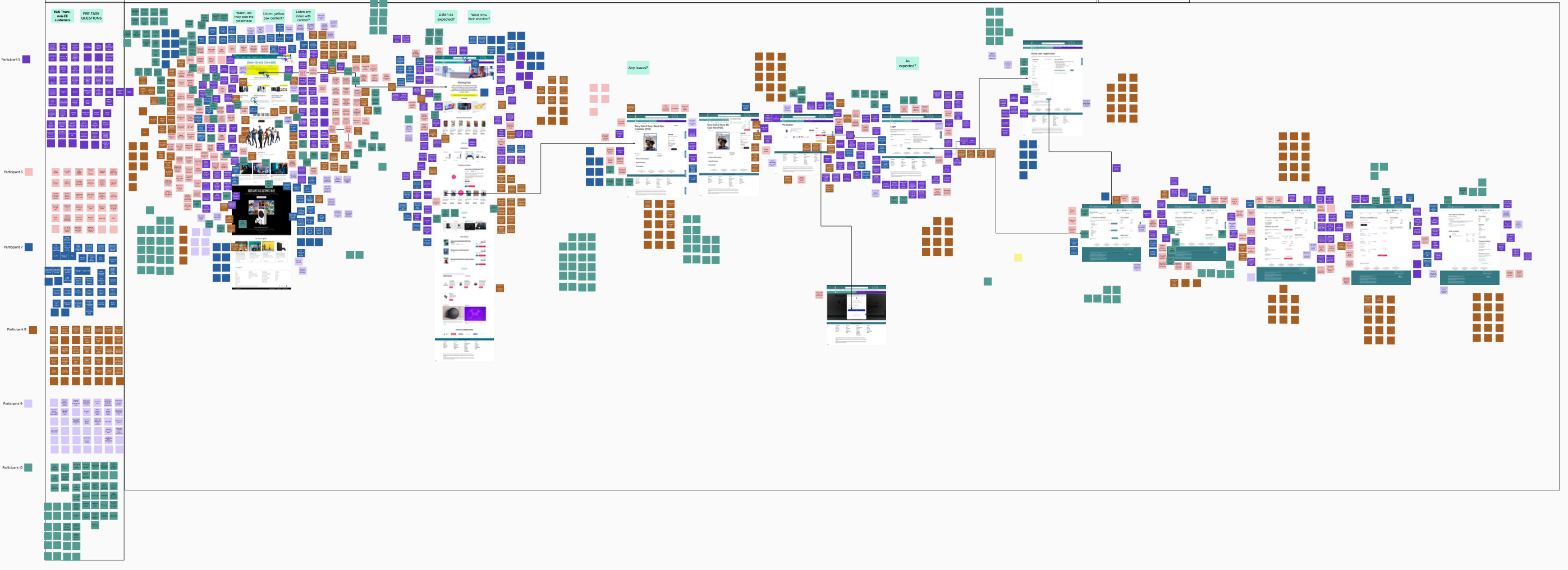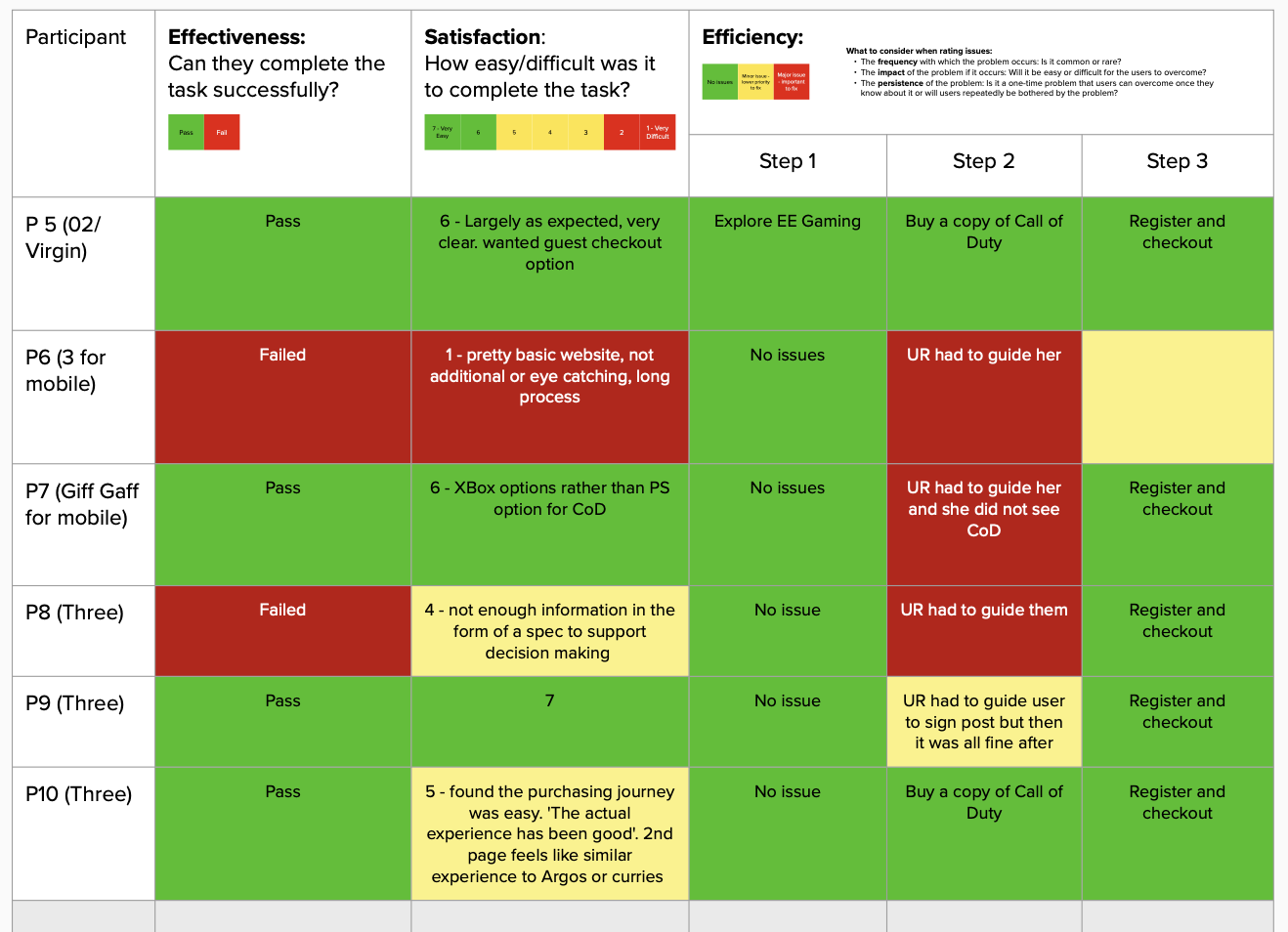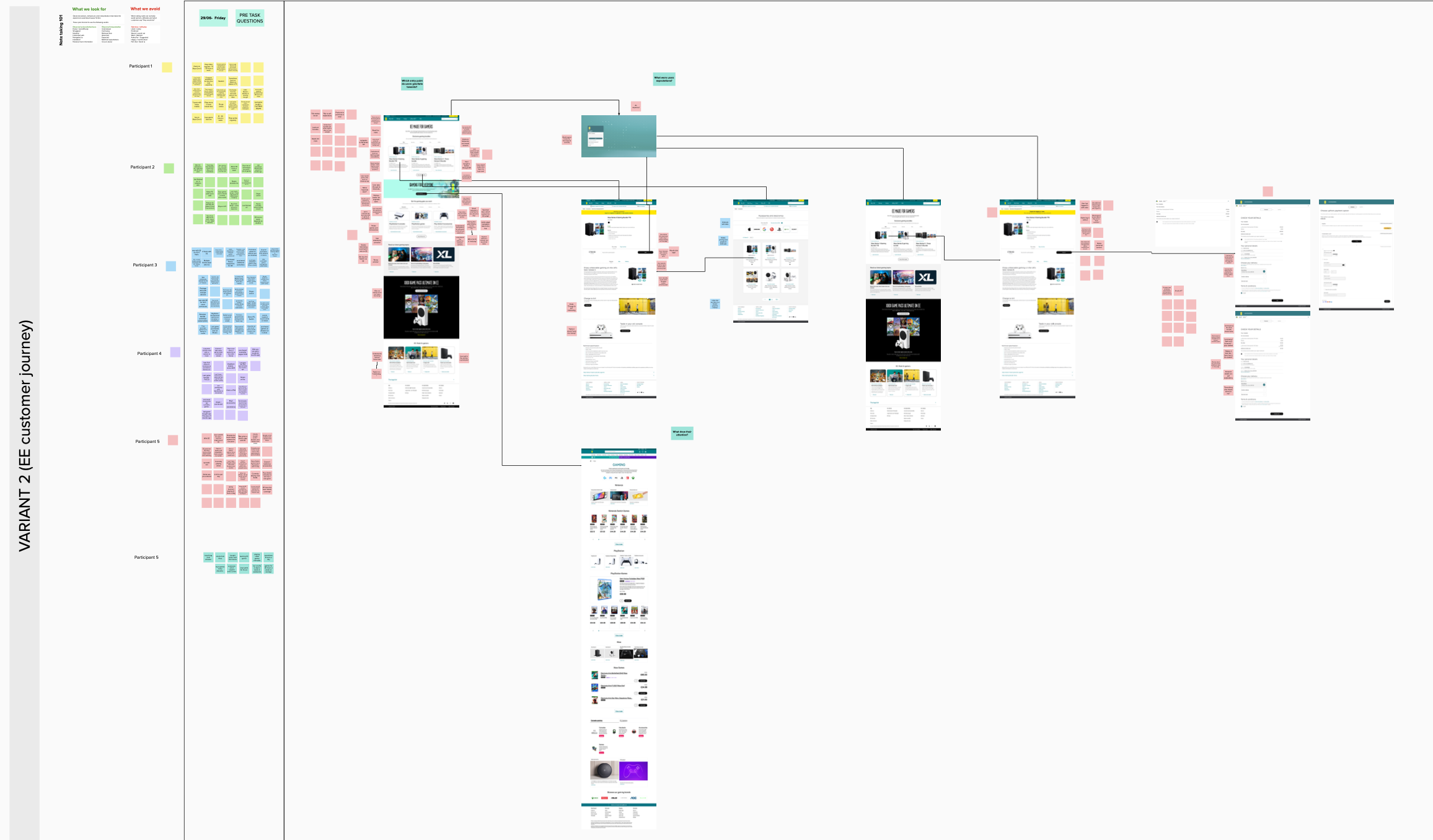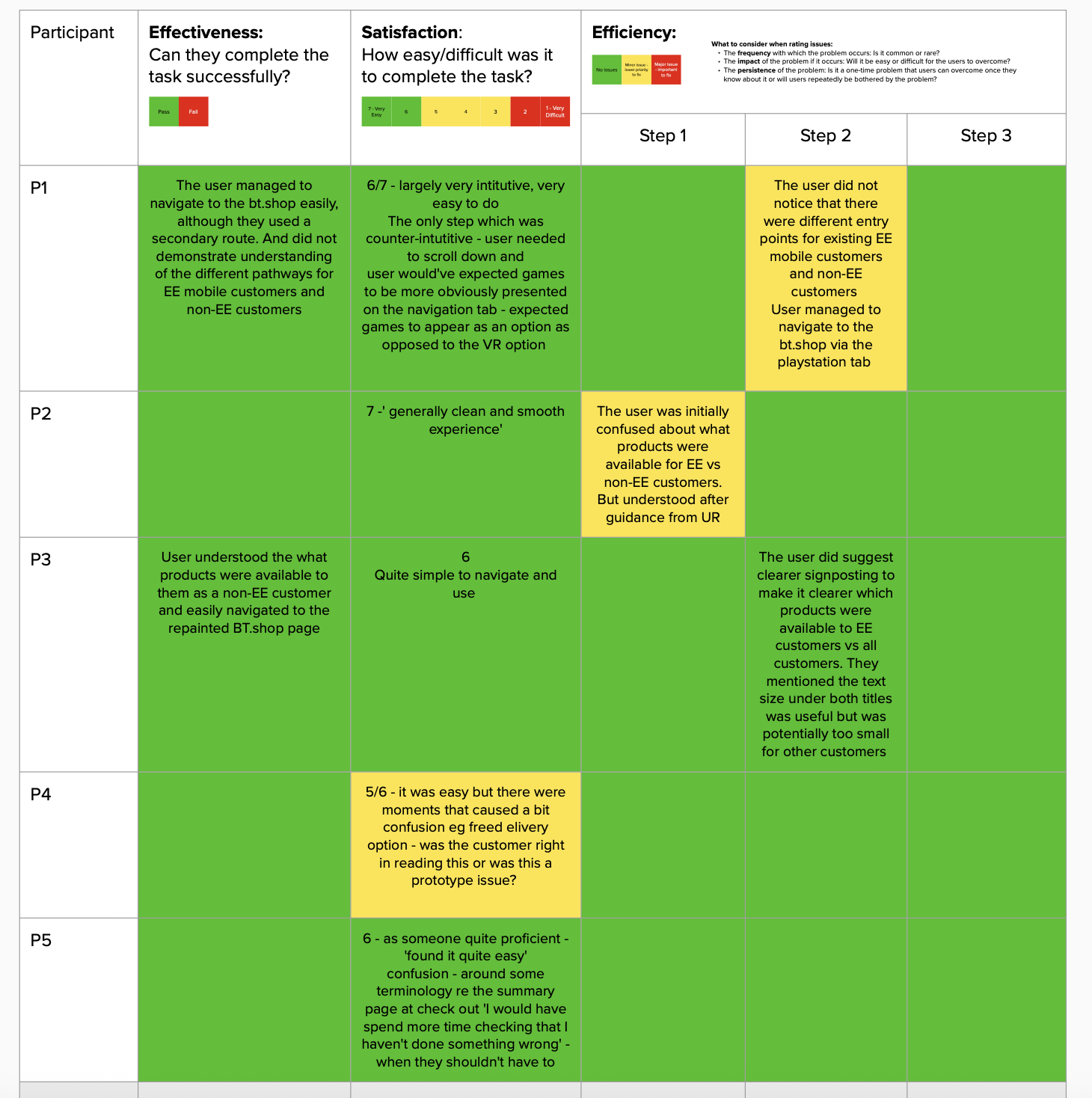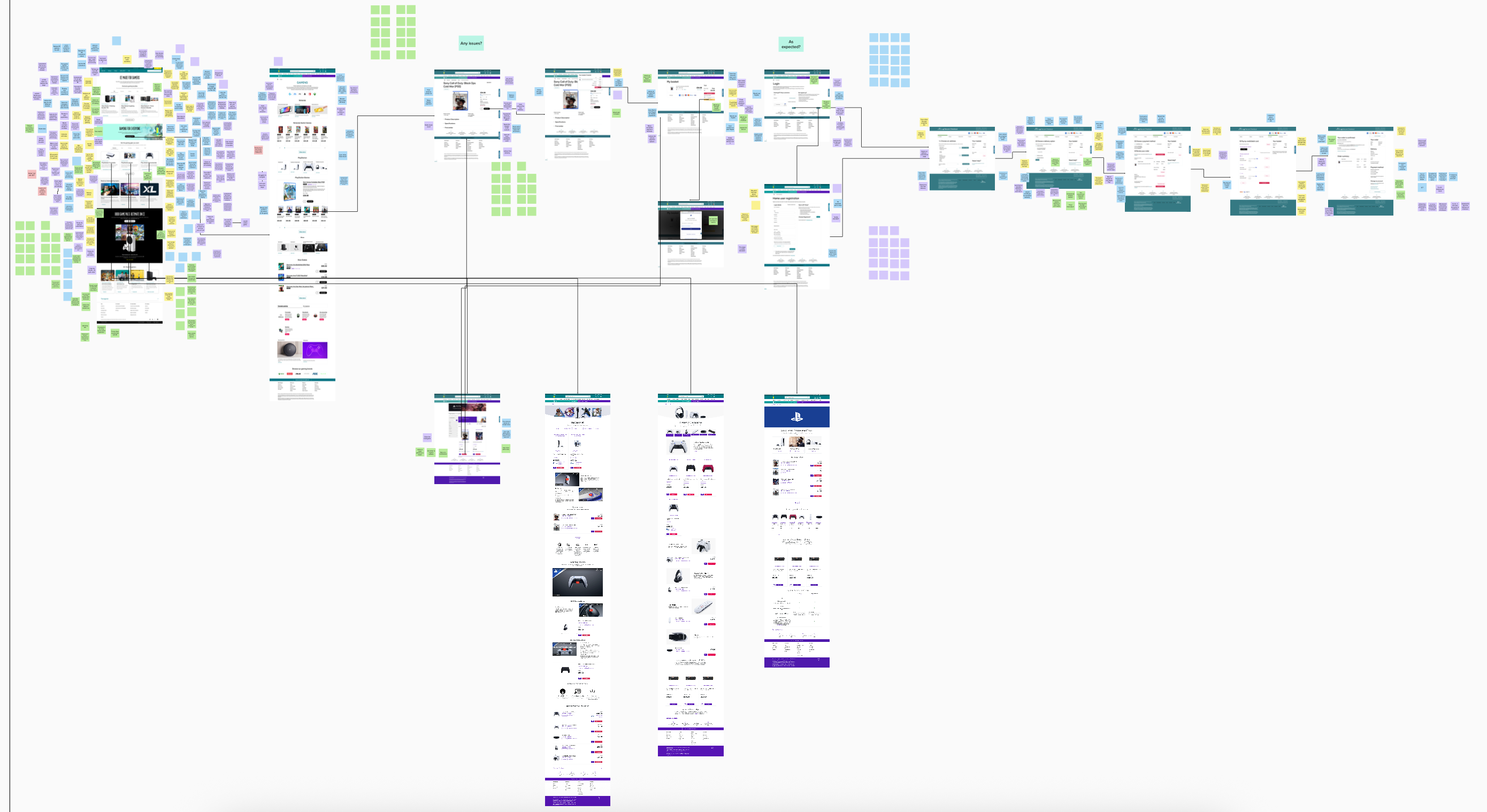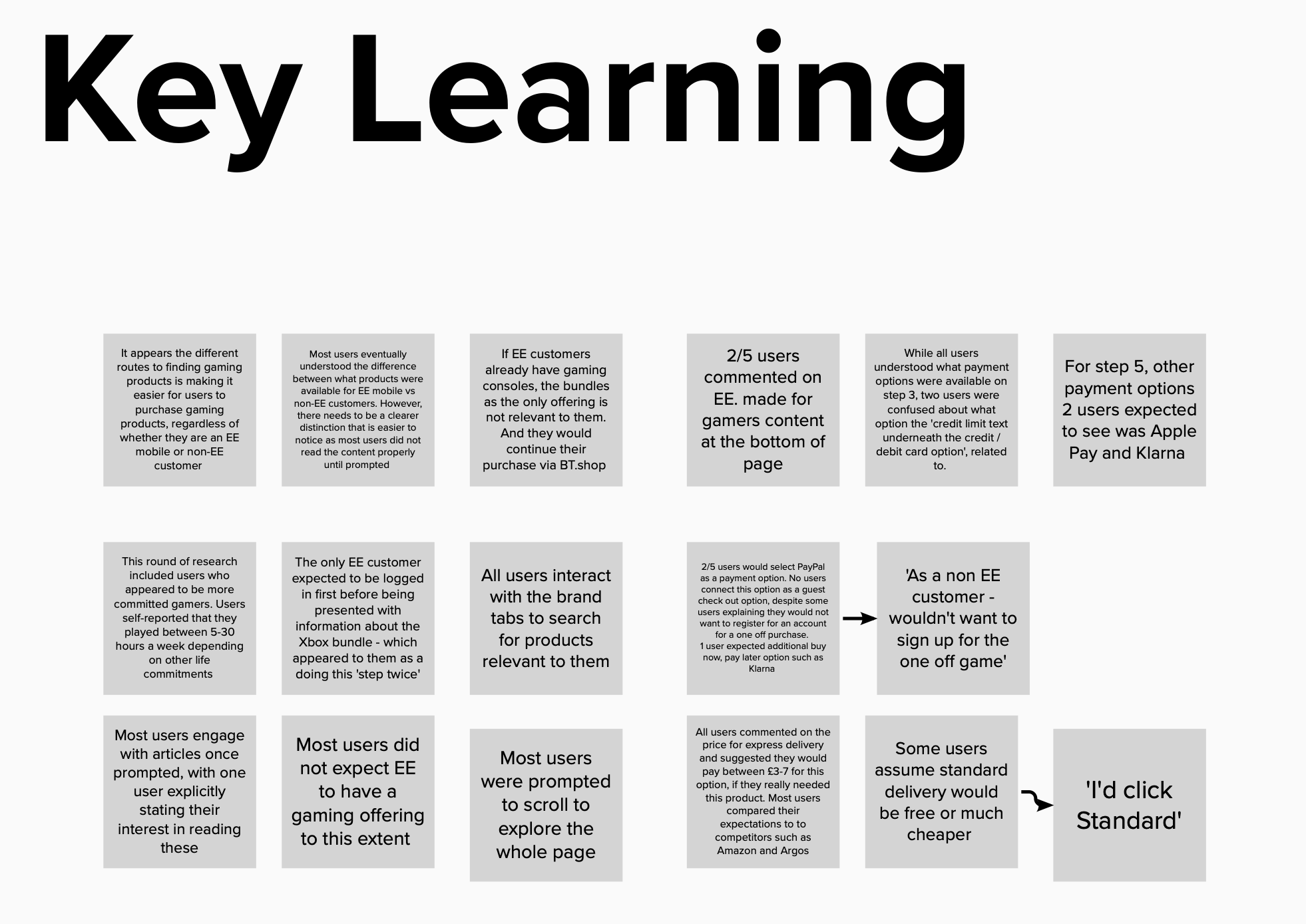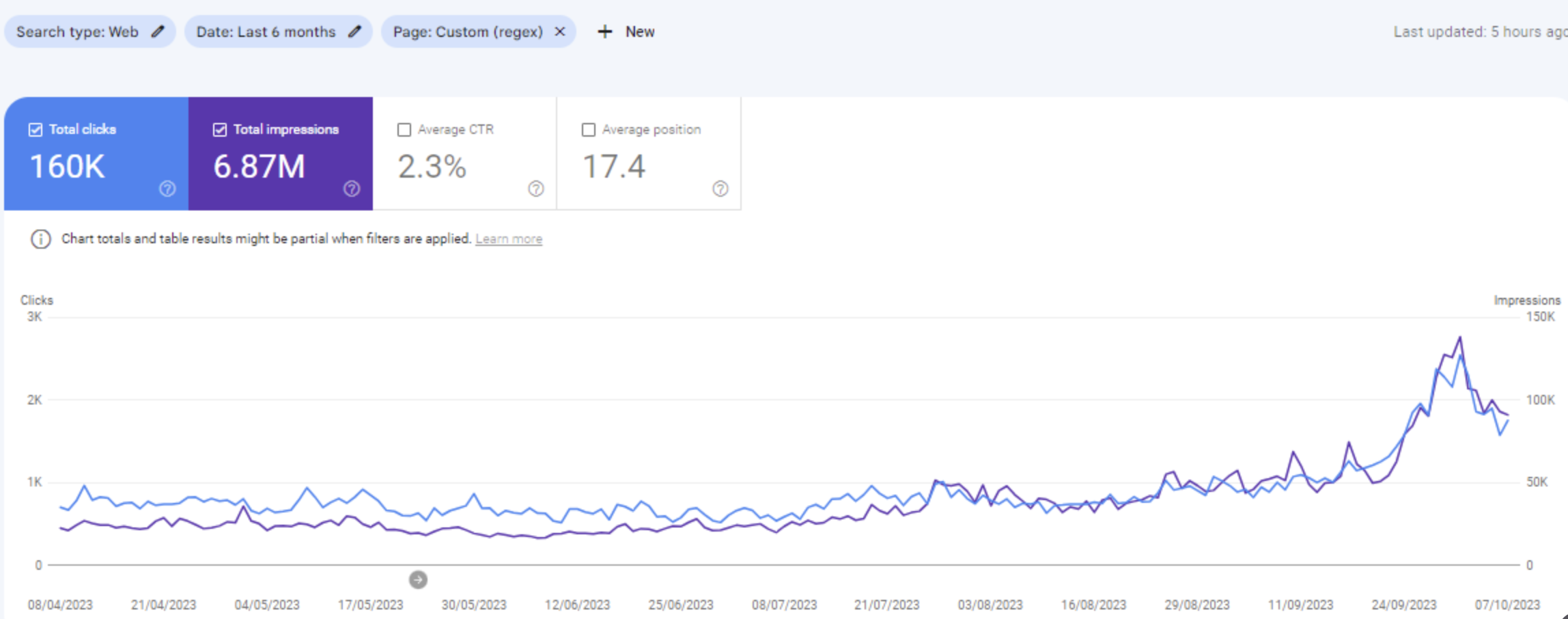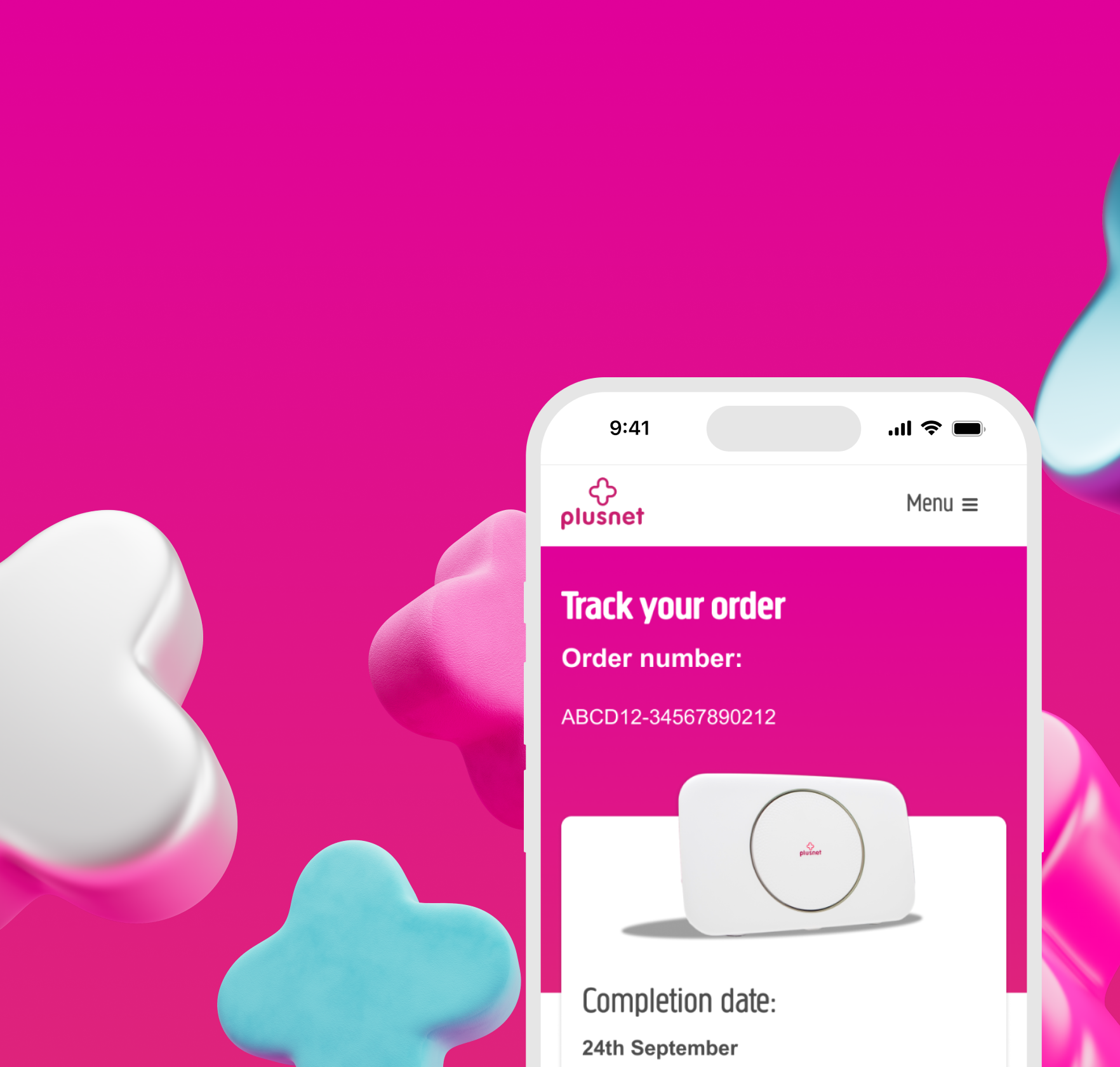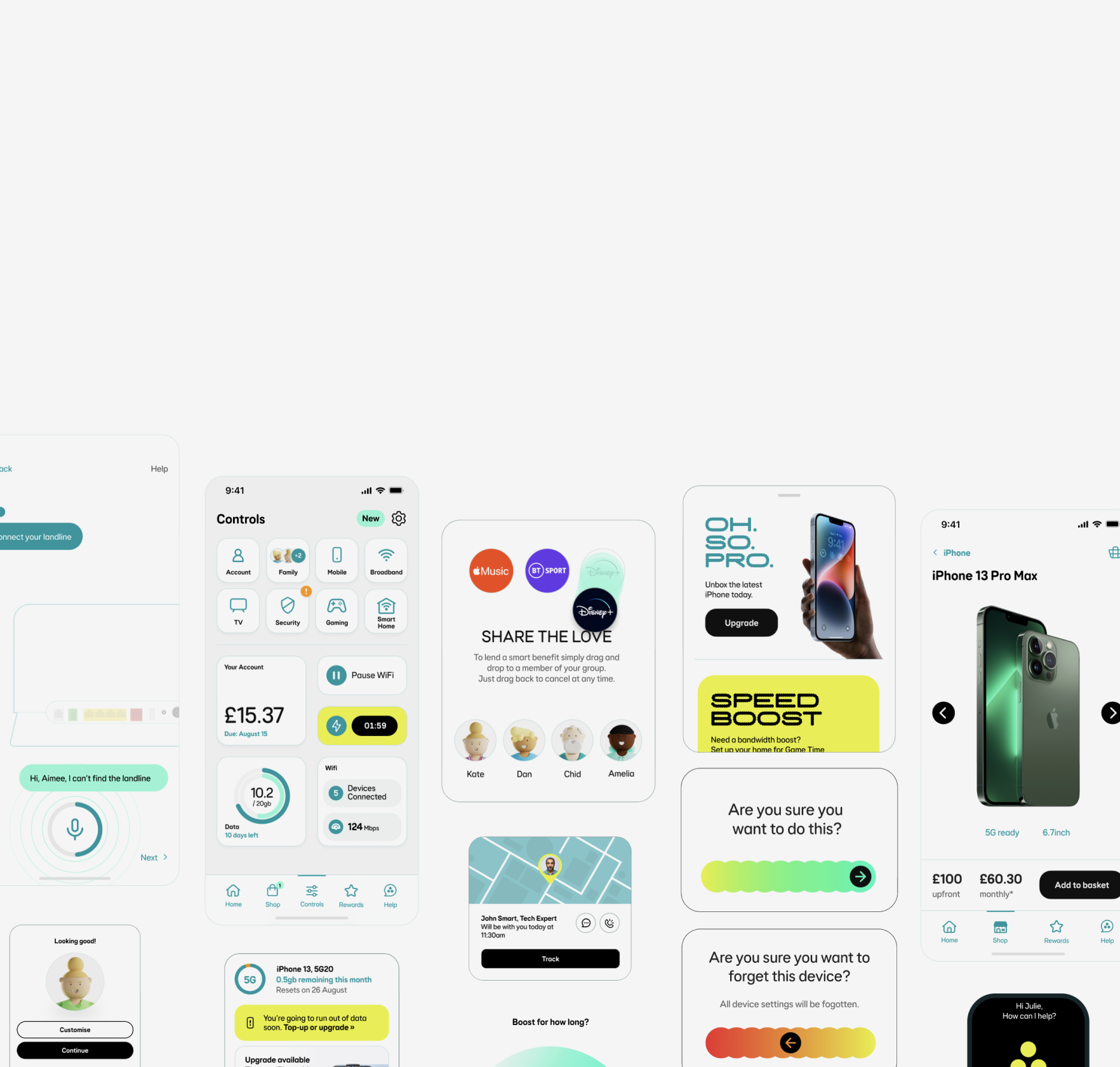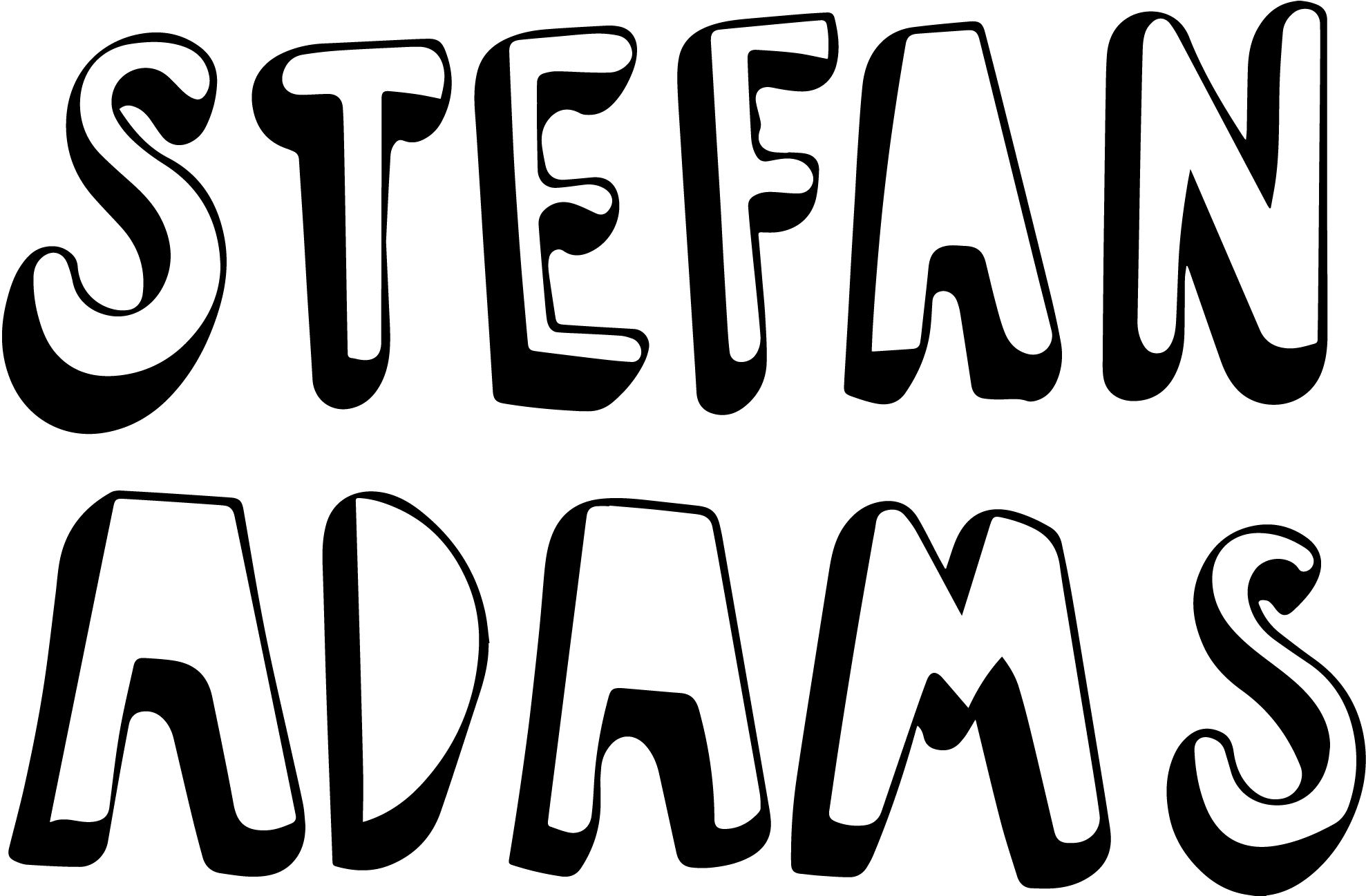Product Design
User Research
User Testing
EE enters the UK’s gaming market
Leading the design of EE’s multi-million-pound entry into the UK gaming market, positioning it as the go-to destination for gamers across all networks.
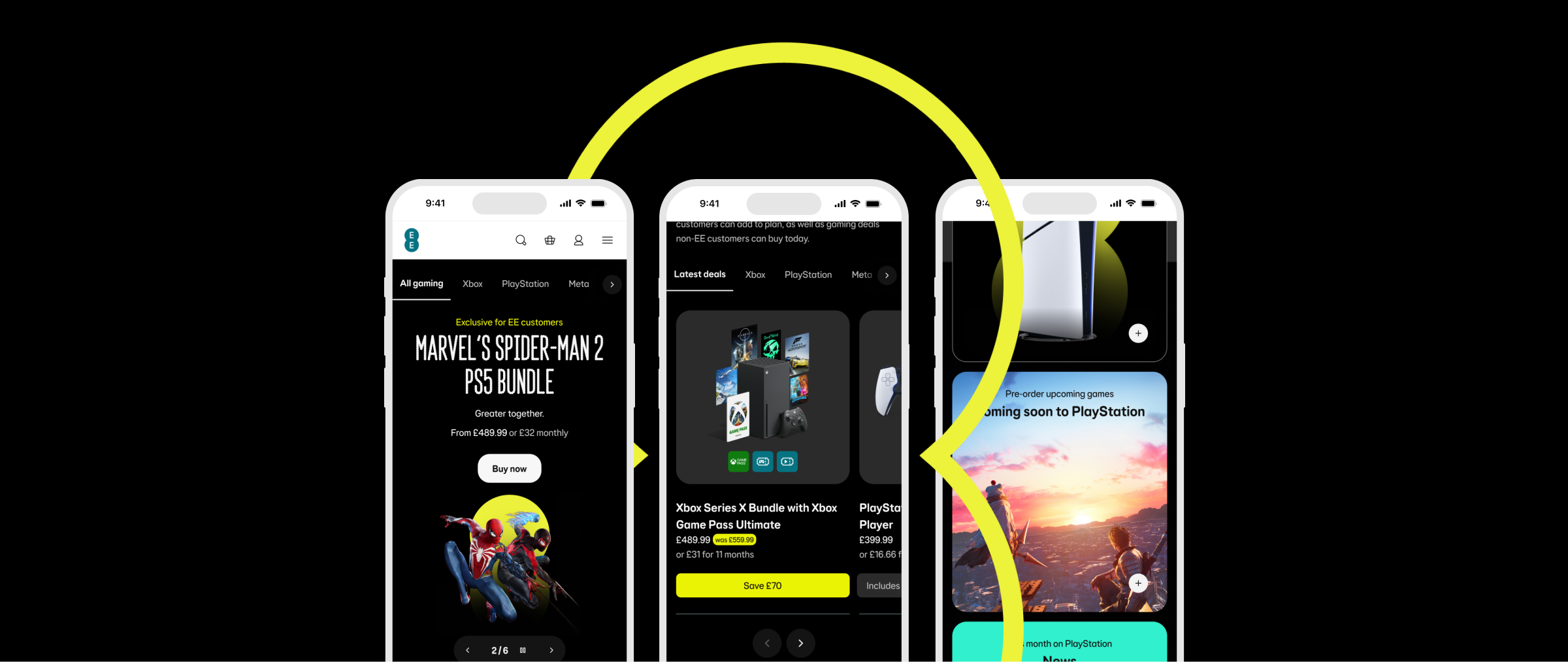
My role
Lead Product Designer
The team
-
Product Manager
-
User Researcher
-
Marketing
-
Accessibility Specialist
-
Content Designer
-
Brand
-
React and Flutter engineers
Background
Gaming is a key new vertical, forecast to generate £72m in revenue this year from both on
and off-net customers.
EE will sell gaming products such as consoles, games, accessories, monitors, PC parts and everything in between.
A brand campaign is planned for the 14th of July with messaging ‘EE Gaming available to
everybody’. Fundamental to this is the use of BT Shop to sell to customers who do not have an existing relationship with us. So this means there will be two websites, one for existing EE customers and one for non-EE customers.
The future plan for this is that these two stores merge, however to meet the deadline of the launch and with technical limitations, they must remeain separate.

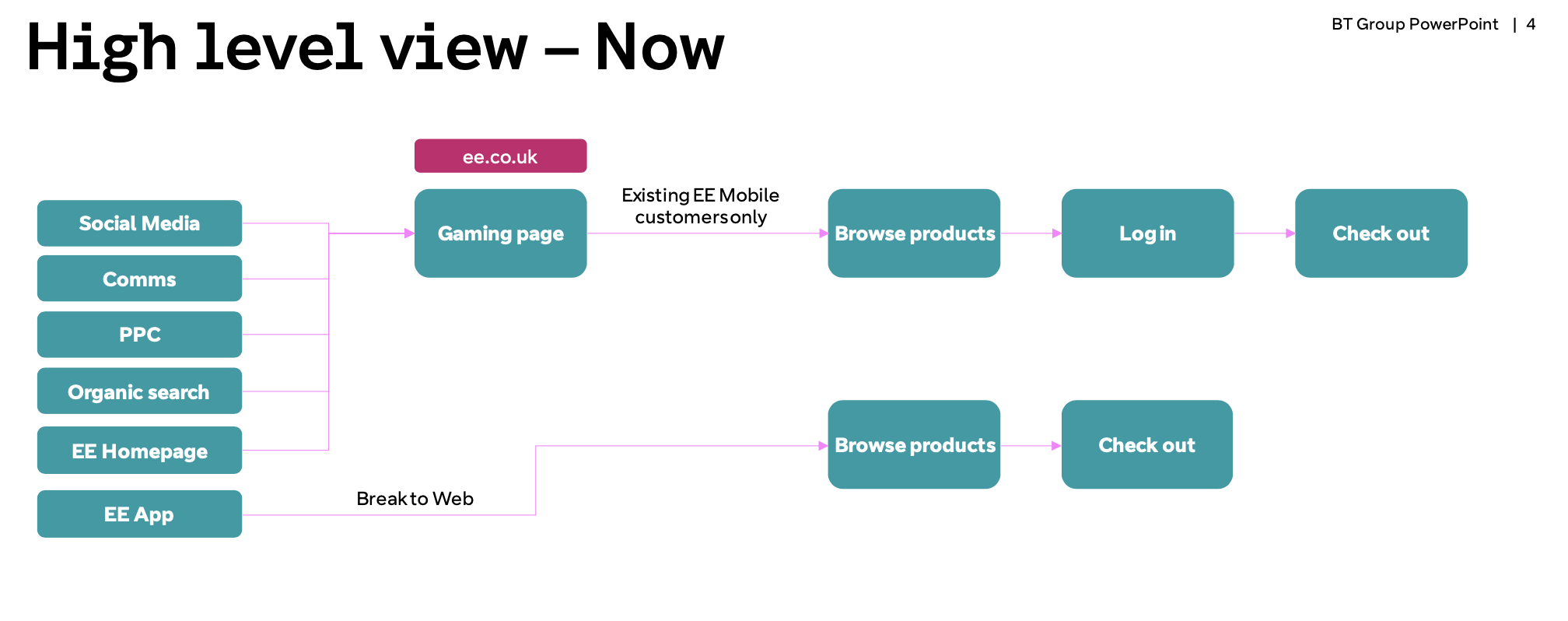
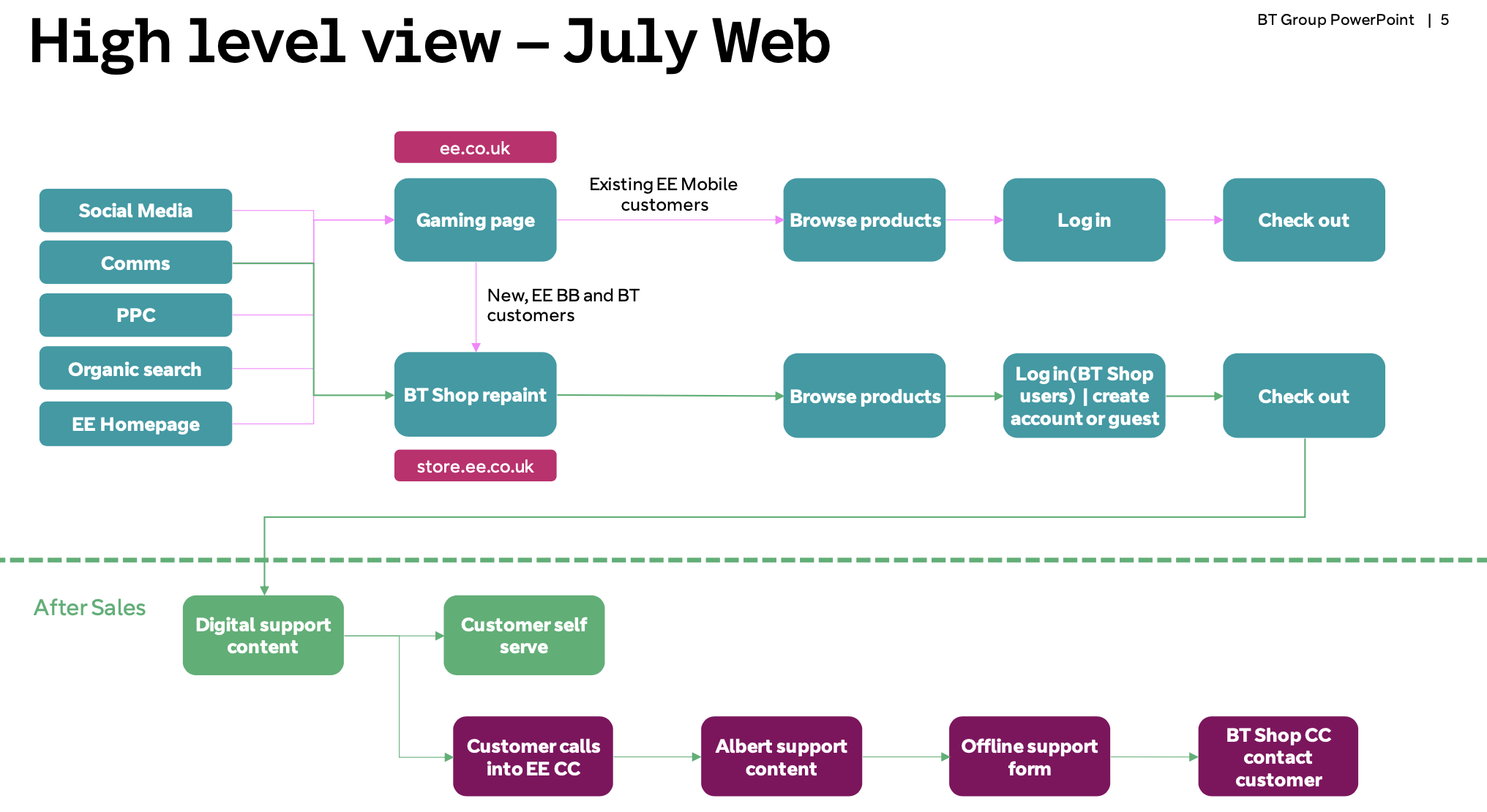
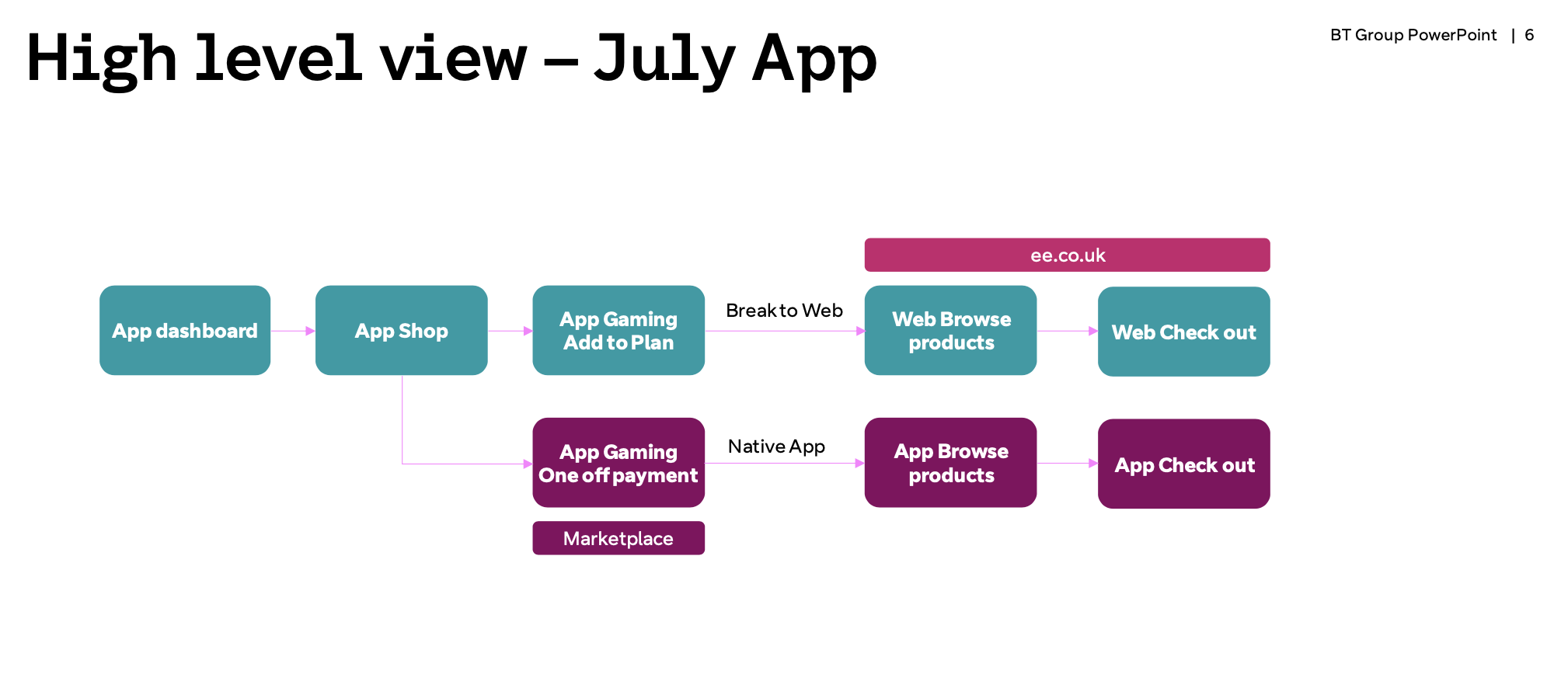
Project goals
01
Propencity to call
We have only been briefed to introduce one new colour. However to make it more scalable and funtional we need tp
02
Unify the EE and BT gaming storefronts
The ask from brand was that this new colour should be used sparingly. It should only replace compnents that currentlt
03
Customer staisfaction
Ensure that existing EE customers benefit from personalised offers or account-linked features, while still allowing non-customers full access to the store and a frictionless purchase path.
04
Customer staisfaction
Design UX flows that reduce barriers to entry, such as unnecessary login prompts, while still enabling account benefits where relevant.
05
Customer staisfaction
Reflect the new, unified EE brand across all touchpoints in the journey, ensuring visual and experiential consistency during the EE and BT brand merge.
EE gaming landing page MVP
To support EE’s entry into the gaming market and begin validating customer interest, we launched a Minimum Viable Product (MVP) gaming store experience for existing EE customers.
This approach was driven by two key constraints: limited development resources and the capabilities of Adobe Experience Manager (AEM). With no dedicated development support available, we designed and built the page using only existing AEM components, ensuring we could go live quickly and within platform limitations.
Focusing the MVP on EE customers allowed us to:
-
Leverage existing account and billing integrations,
-
Operate within known customer journeys,
-
And start gathering early insights without requiring backend changes.
This pragmatic MVP approach enabled us to move fast, test core assumptions, and lay the foundation for a broader, unified experience that will eventually serve both EE and non-EE users as part of the merged brand strategy.
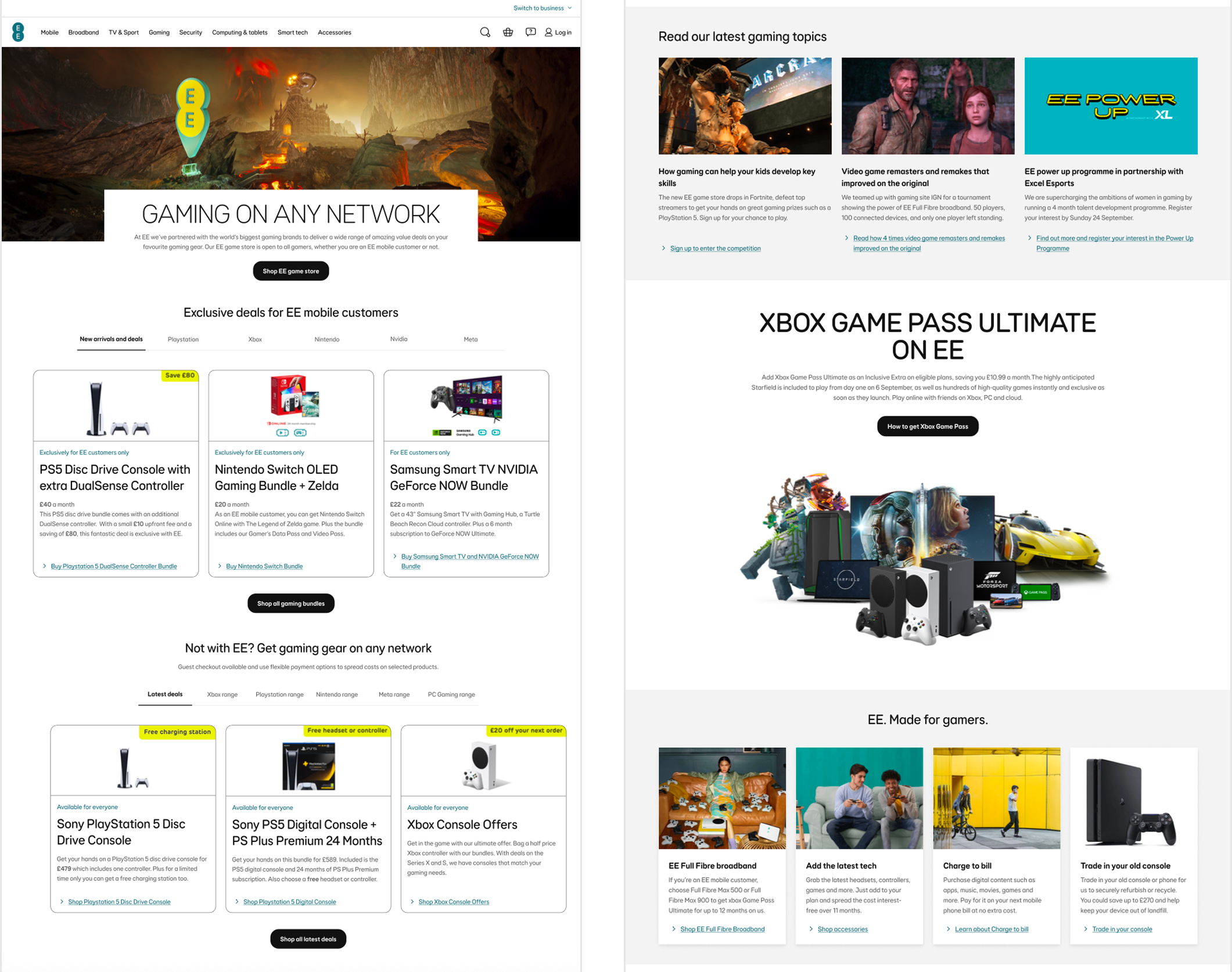
Journey mapping and competitor analysis
Existing and non-existing EE customer journey’s
Following the MVP launch, we conducted detailed journey mapping to understand the end-to-end experience for both existing EE customers and non-EE users. This work aimed to identify pain points, inconsistencies, and opportunities to create a more unified and inclusive gaming purchase journey.
For Existing EE Customers:
-
We mapped how customers discover, access, and navigate the gaming store through EE-owned channels.
-
Focus was placed on login flows, personalised offers, and device financing options linked to their account.
-
We identified areas where the experience is smooth (e.g. leveraging account info) and where it becomes fragmented or overly complex (e.g. unclear eligibility or gating).
For Non-Existing EE Customers:
-
We explored how non-customers currently interact with the BT gaming store or are blocked from accessing EE’s store.
-
Key friction points included gated access, inconsistent branding, and unclear messaging around who can buy and how.
-
The journey mapping highlighted the need for a more inclusive experience that allows all users to browse and purchase without feeling excluded.
These journey maps are now guiding design decisions for the future-state unified experience, ensuring that no matter who the user is or which channel they arrive from, they can easily explore and purchase gaming products with minimal friction.
Pain points (which are assumed as we have not run any user research for this journey):
-
Initial confusion once customers landed on the EE Gaming Hub and the rebranded BT shop page.
-
Overwhelming choice of products and services on the rebranded BT shop website.
-
A need for clearer CTAs for payment, log in and delivery options.
-
Eligibility of voucher codes.
-
Routes for customers to seek assistance for returns or other service issues.
Opportunities - Creating clear content:
-
To to help sign post users once they land on the EE Gaming Hub to the relevant next step.
-
To explain wider offering on the rebranded BT shop website.
-
For payment CTAs, delivery and log in options.
-
For help articles.
-
To encourage customers to complete their order if they've abandoned their basket, reframed as a wish list.

Gaming engagement programme overview
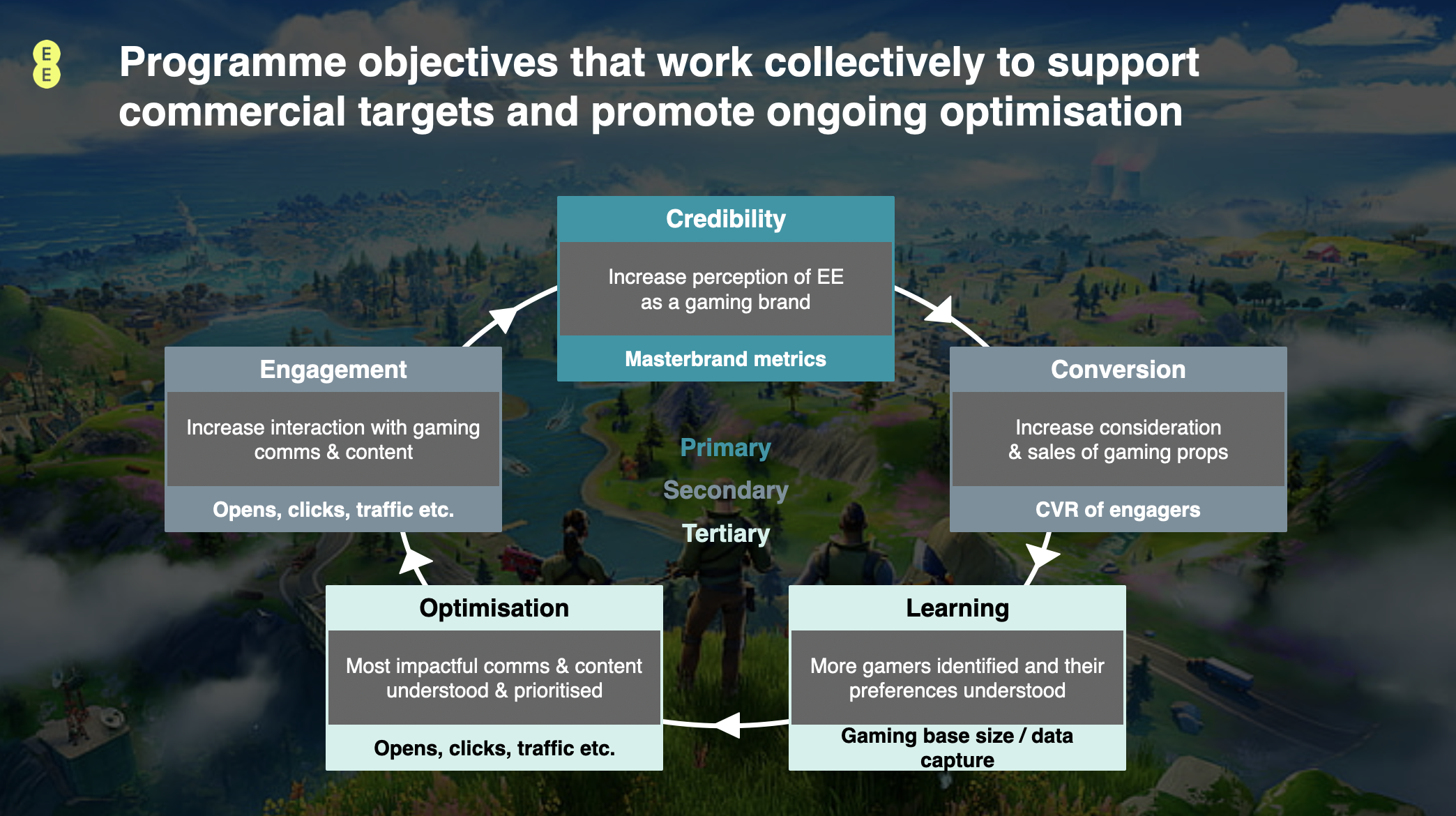
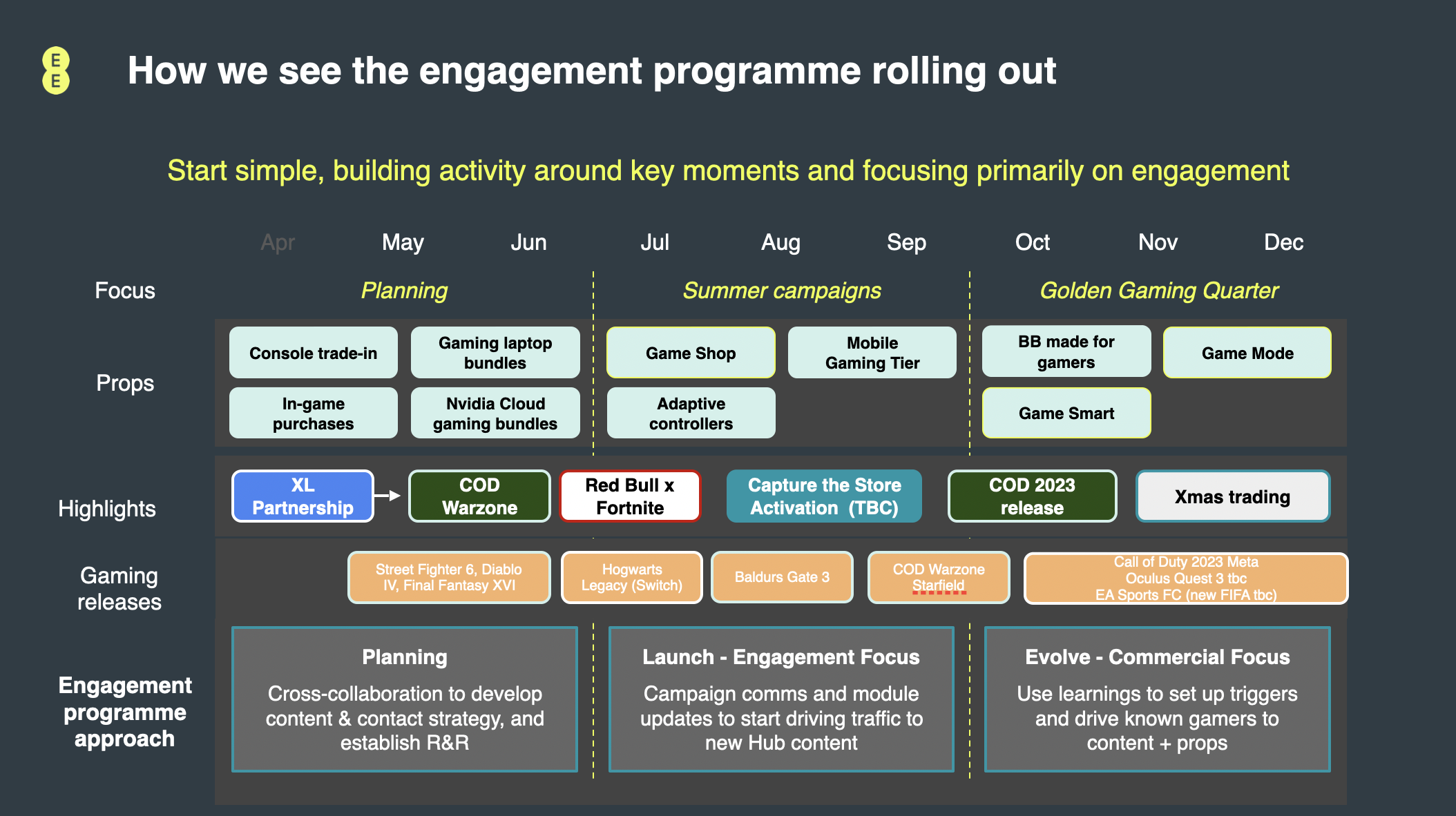
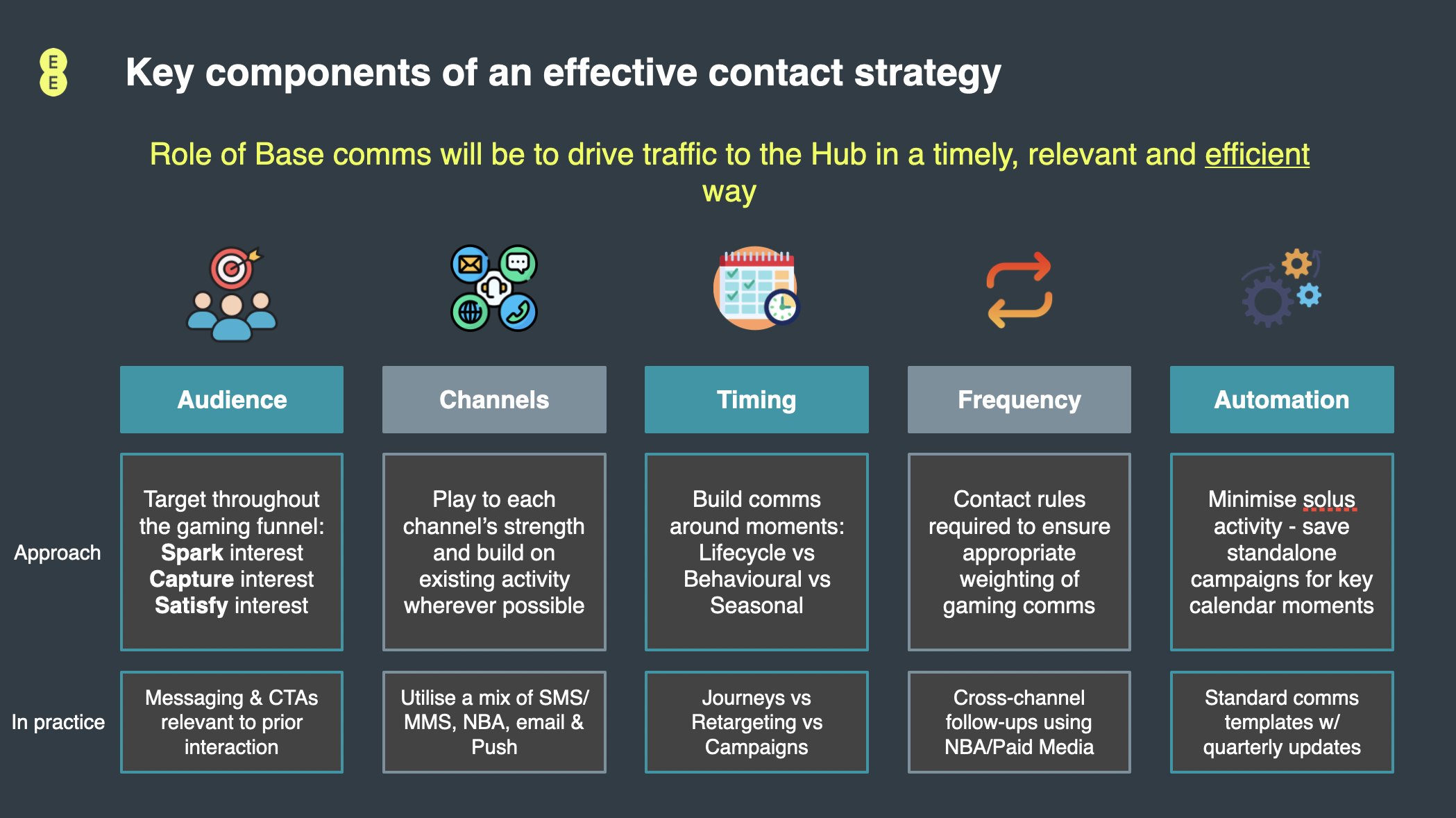
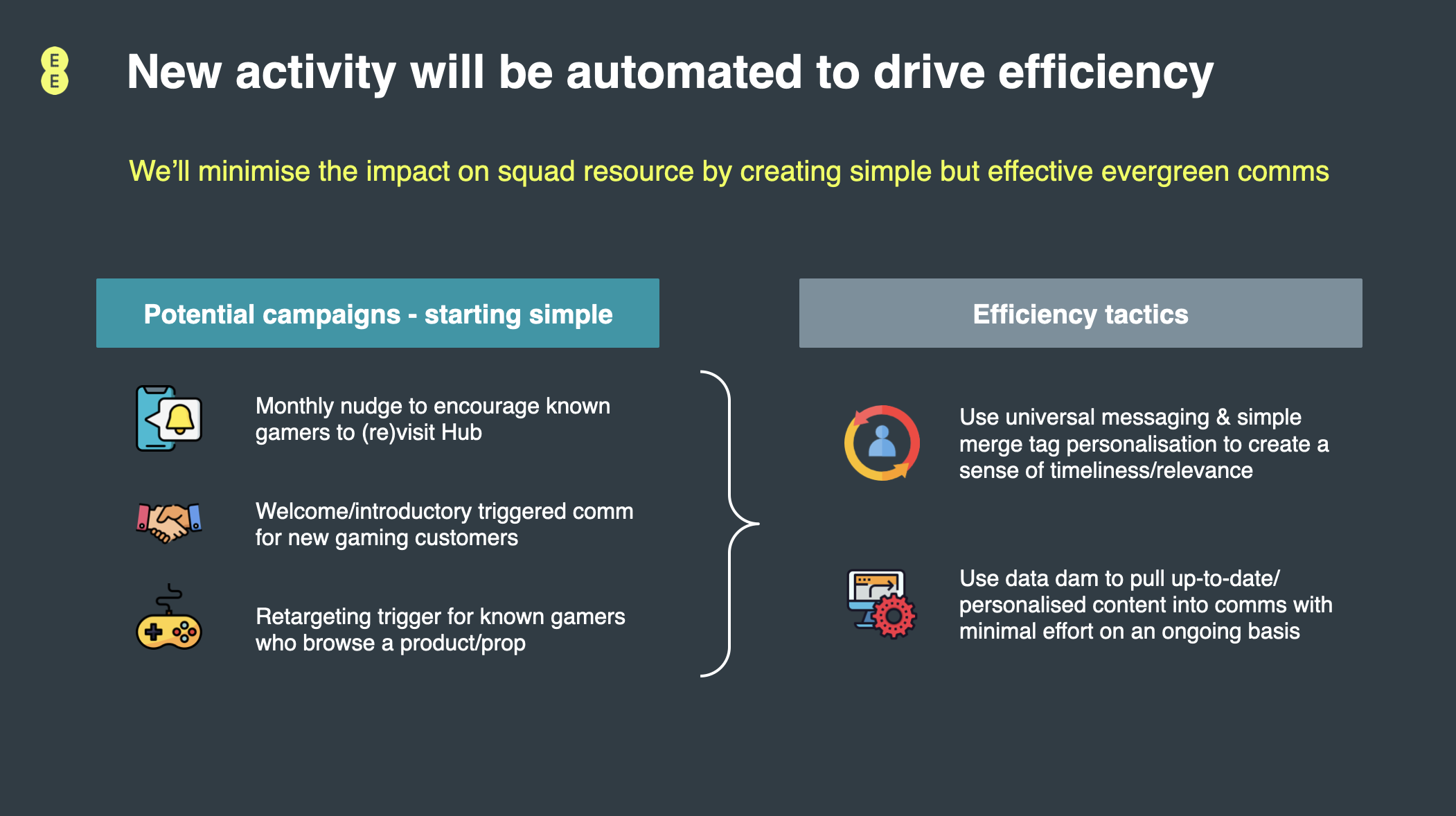
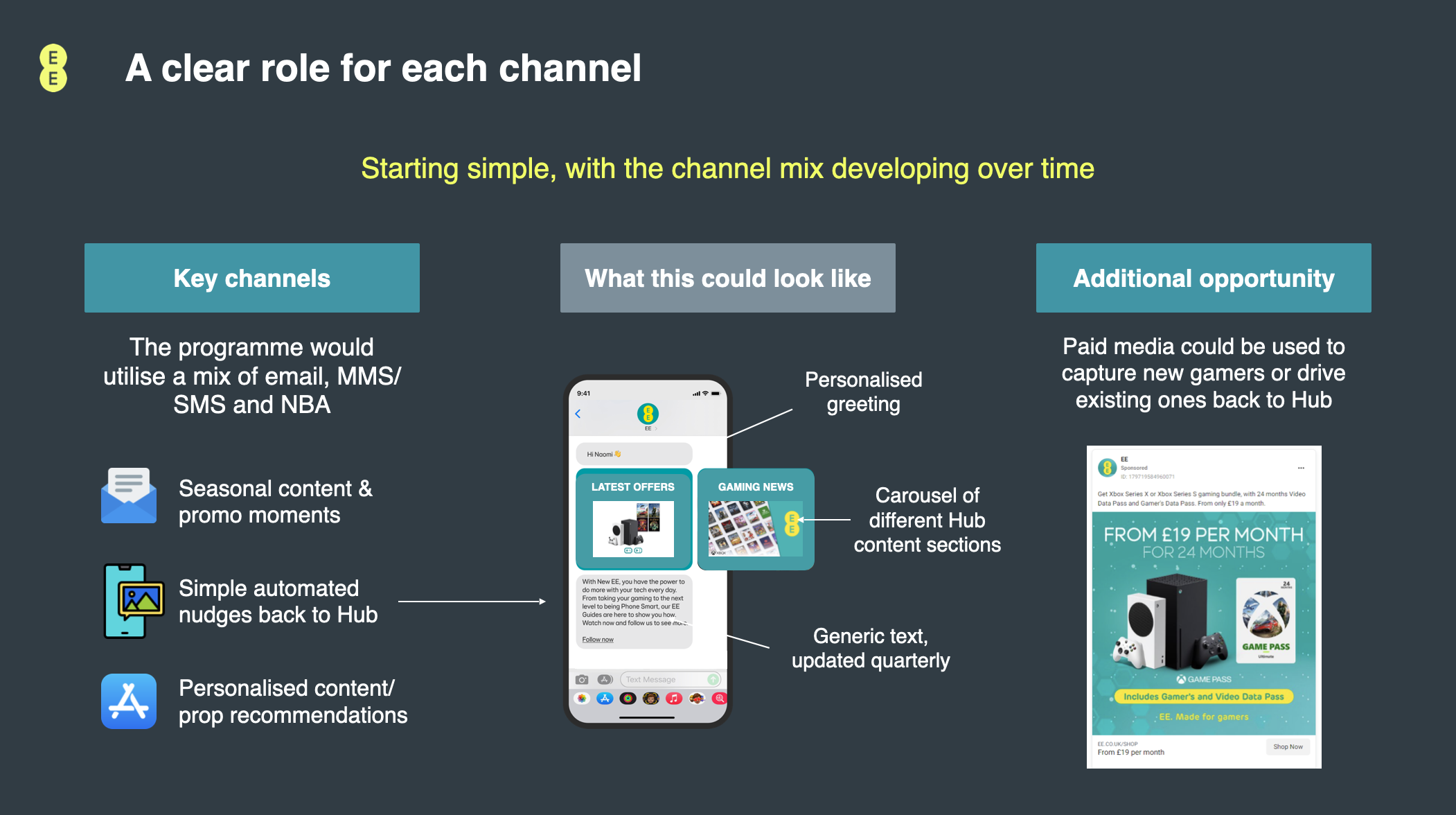
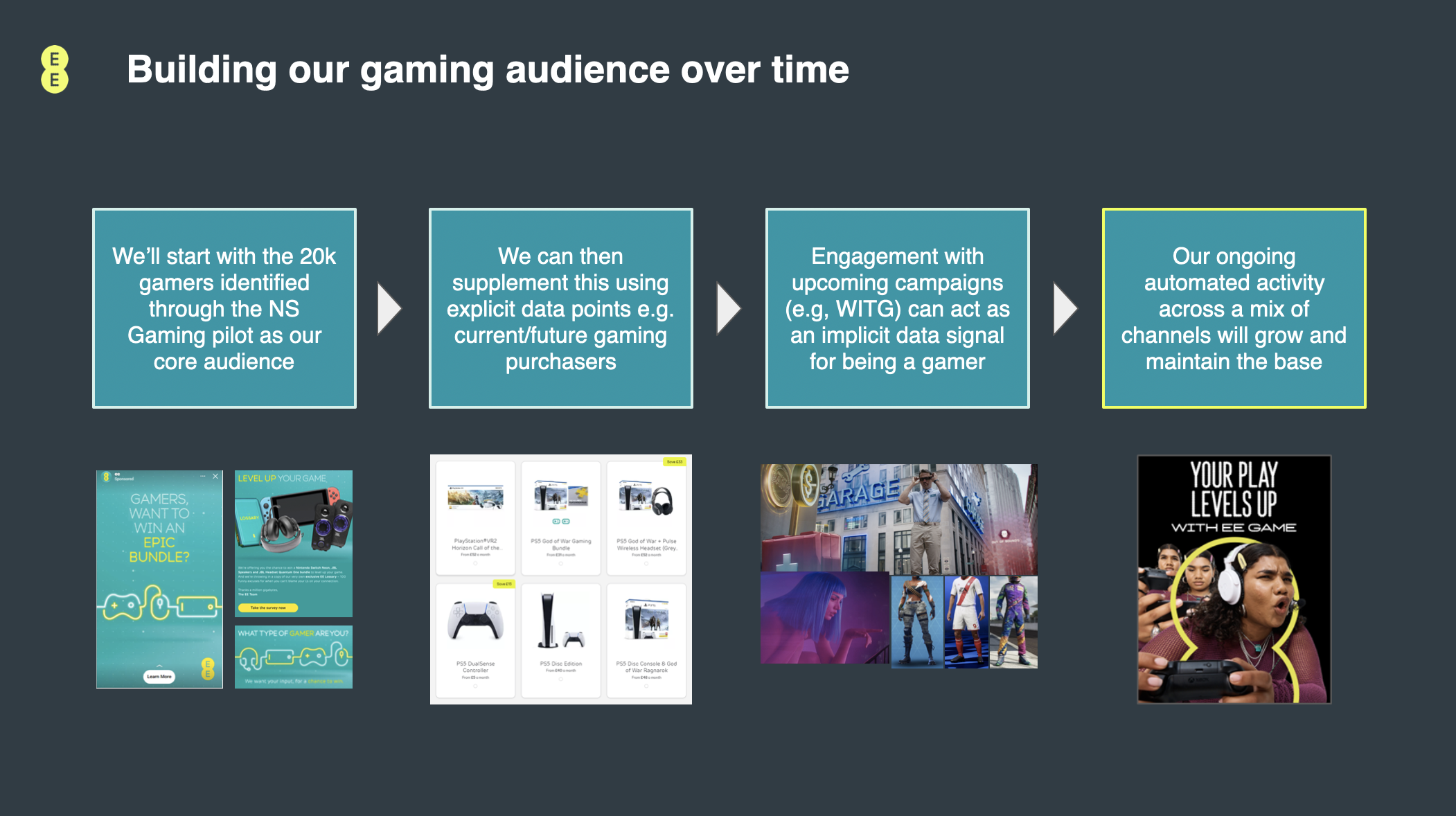
What do the main three gaming pages offer and what should they offer?
The gaming need state page is an educational page about the four main areas of EE: Work, Learn, Home and Gaming.
Iterating on the MVP design and user testing
After launching the MVP for EE customers, we began iterating on the design to prepare for user testing. The goal was to validate core assumptions, uncover usability issues, and understand how both EE and non-EE users interact with the experience.
Working within the existing AEM component limitations, we made lightweight design updates focused on:
-
Improving content clarity and hierarchy.
-
Enhancing navigation and product discovery.
-
And refining key moments like the add-to-basket and checkout flows.
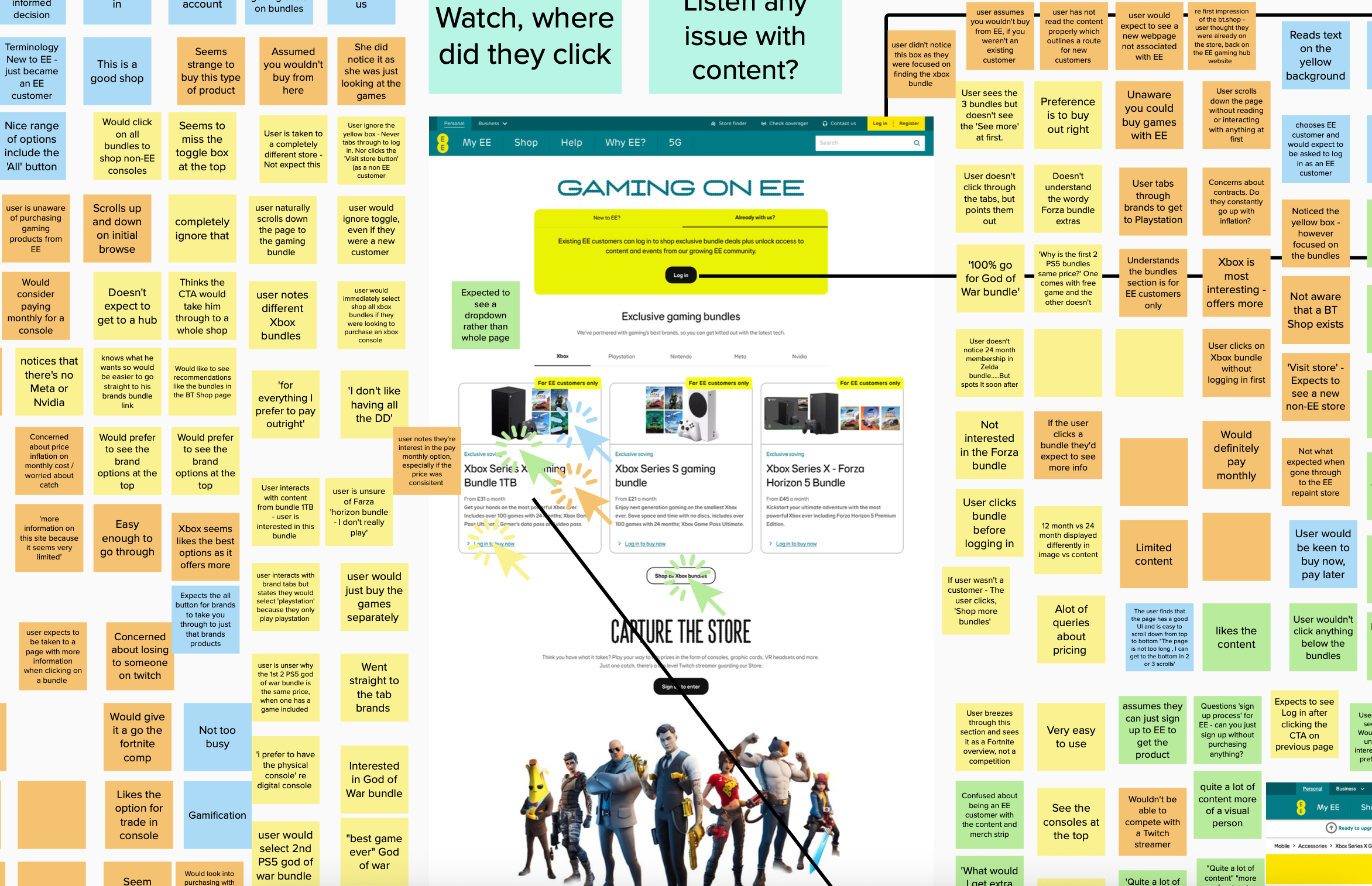
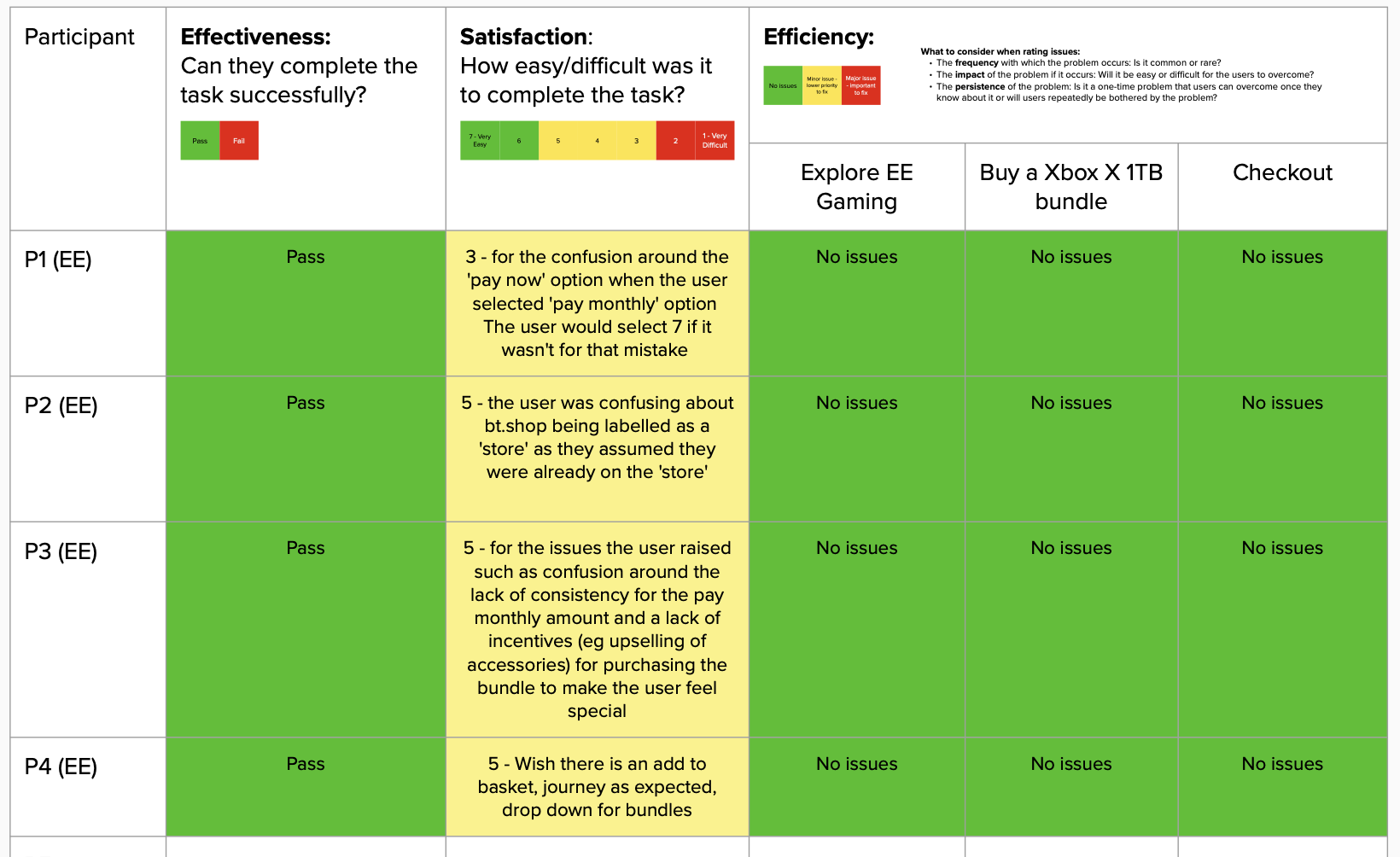
Iterrating on
Participants: 4 x non-EE customers, 4 x EE customers, 2 x self identified gamers (remote and in person testing in labs
Key findings:
-
The yellow banner/ box did not draw the users attentions, the bundles did and users were very fixated on them.
-
In addition to not drawing the users attentions, some users informed us during the sessions that they simply ignored the yellow banner/ box even thought they saw it because they were drawn to the bundles.
-
Users noted the EE exclusive labels - however, it would not immediatelymake them interested in signing up to
have an EE account. They expected to
be EE mobile customers in order to get
those deals.
-
Users noted the EE exclusive labels - however, it would not immediatelymake them interested in signing up to
have an EE account. They expected to
be EE mobile customers in order to get
those deals.
-
Users noted the EE exclusive labels - however, it would not immediatelymake them interested in signing up to
have an EE account. They expected to
be EE mobile customers in order to get
those deals.
-
Users noted the EE exclusive labels - however, it would not immediatelymake them interested in signing up to
have an EE account. They expected to
be EE mobile customers in order to get
those deals.
-
Users noted the EE exclusive labels - however, it would not immediatelymake them interested in signing up to
have an EE account. They expected to
be EE mobile customers in order to get
those deals.
-
Users noted the EE exclusive labels - however, it would not immediatelymake them interested in signing up to
have an EE account. They expected to
be EE mobile customers in order to get
those deals.
Designing with dev resource
With dedicated development resource now available, we’re moving beyond the MVP constraints and can begin designing a more robust, scalable version of the gaming page for both web and app. This allows us to break free from the limitations of existing AEM components and introduce custom functionality, improved UI patterns, and a more refined user experience. We can now design with greater flexibility optimising layouts, enhancing performance, and ensuring consistency across platforms while aligning with the unified EE brand. This phase also enables deeper integration with account services, personalisation, and more advanced commerce capabilities.
For a deep dive into the user research conducted for this iteration click the button below:
Benchmarking user research
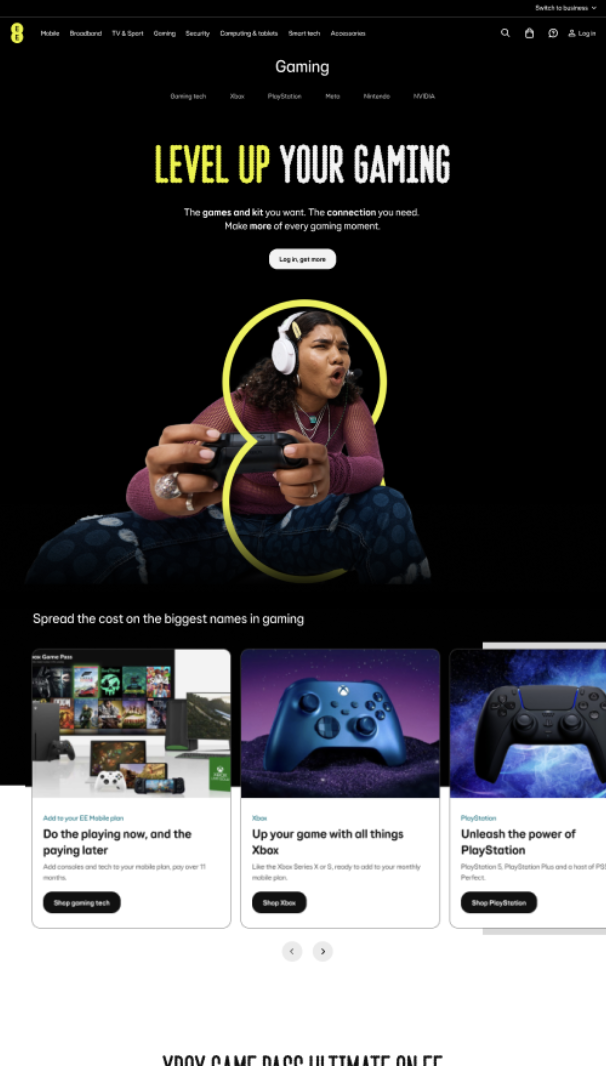
Going live V2 design
With dedicated development resource now available, we’re moving beyond the MVP constraints and can begin designing a more robust, scalable version of the gaming page for both web and app. This allows us to break free from the limitations of existing AEM components and introduce custom functionality, improved UI patterns, and a more refined user experience. We can now design with greater flexibility optimising layouts, enhancing performance, and ensuring consistency across platforms while aligning with the unified EE brand. This phase also enables deeper integration with account services, personalisation, and more advanced commerce capabilities.
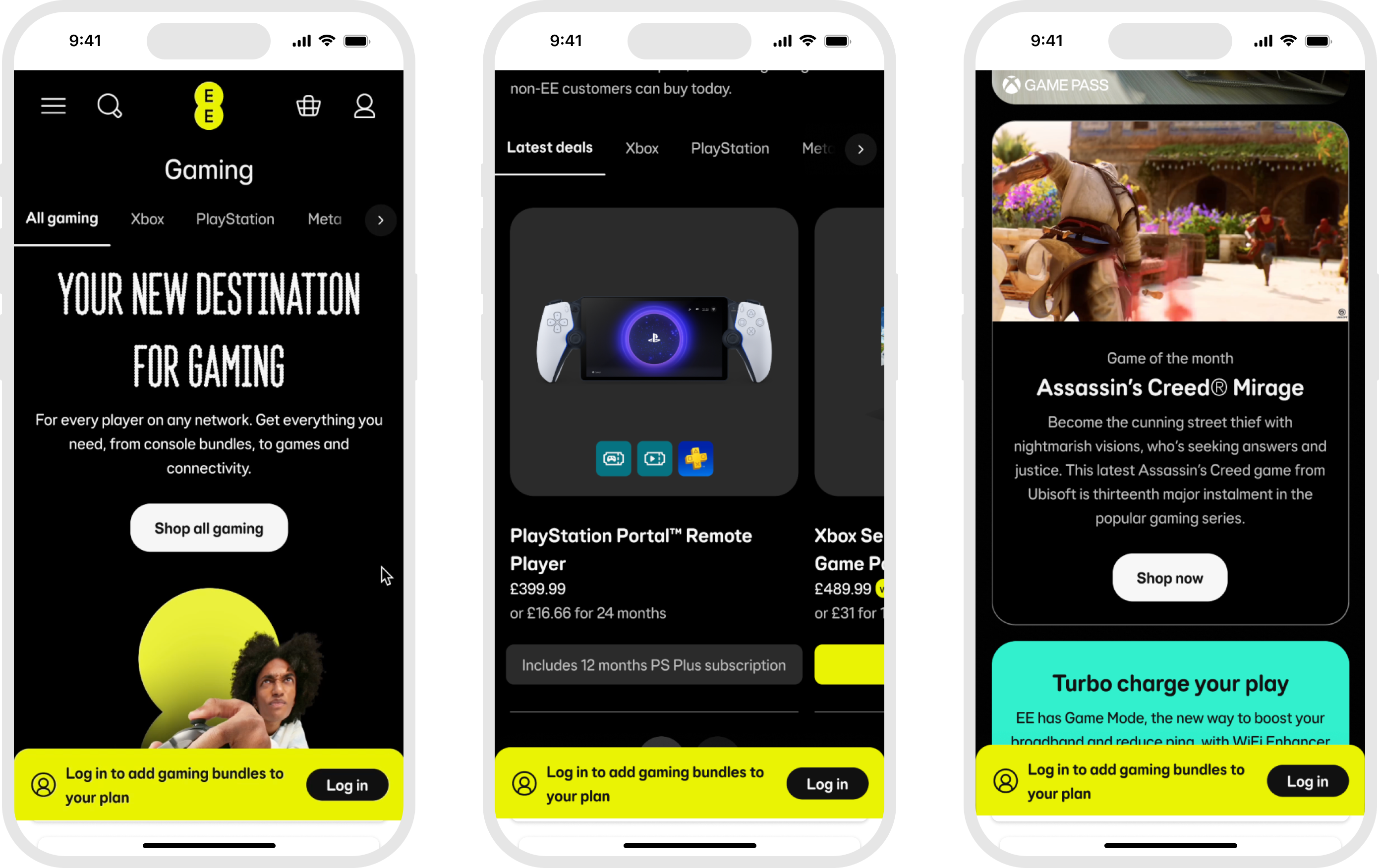
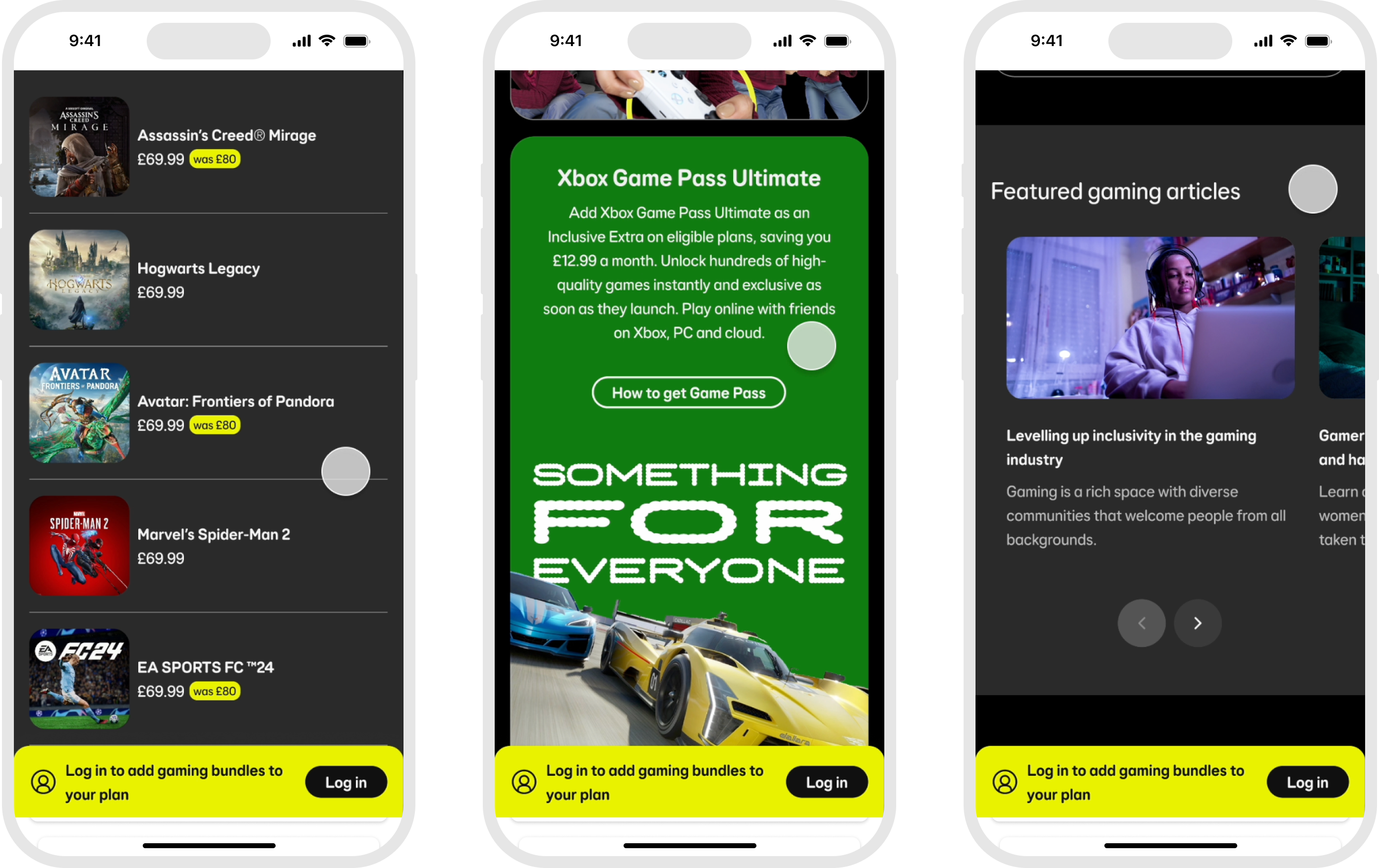
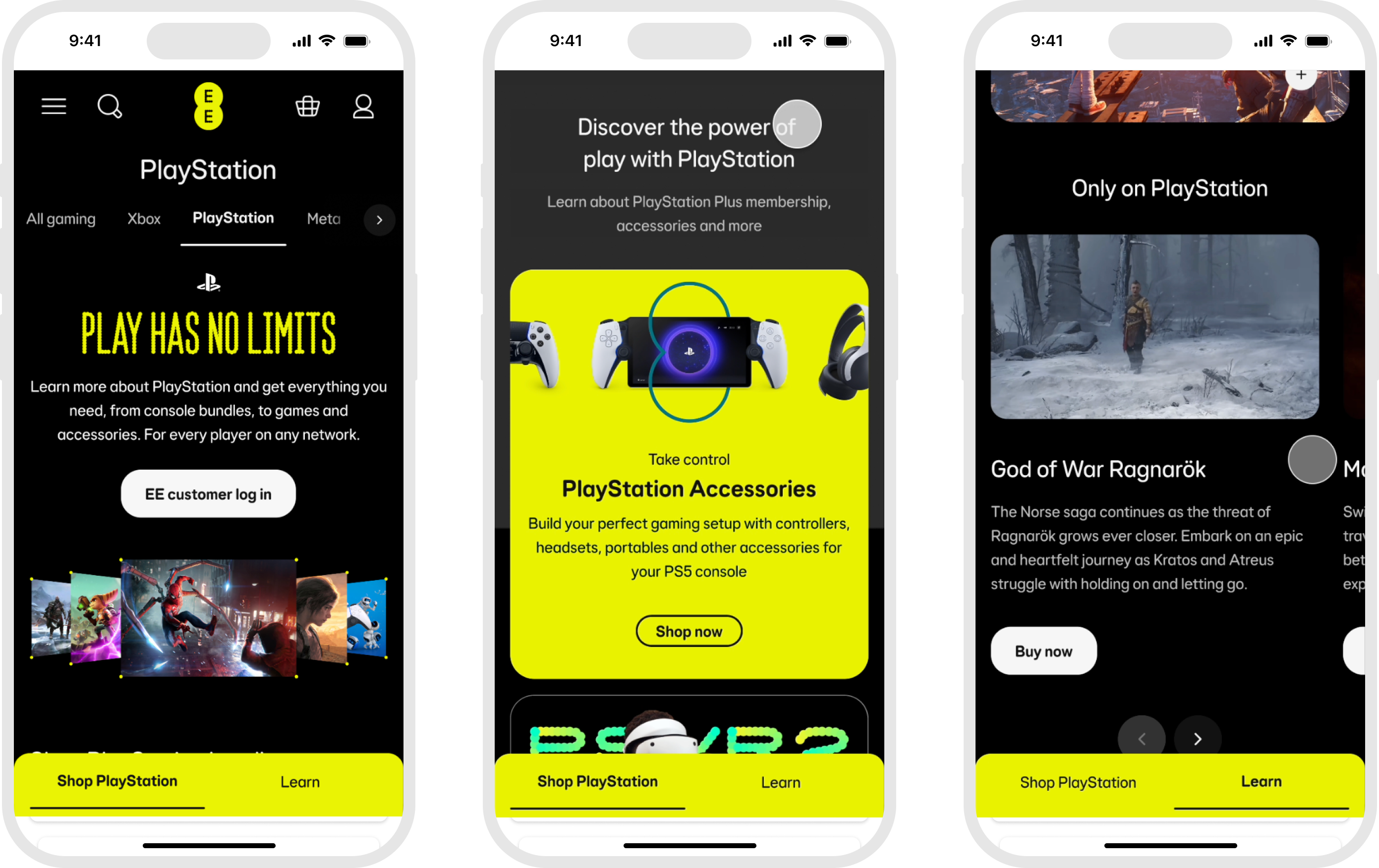
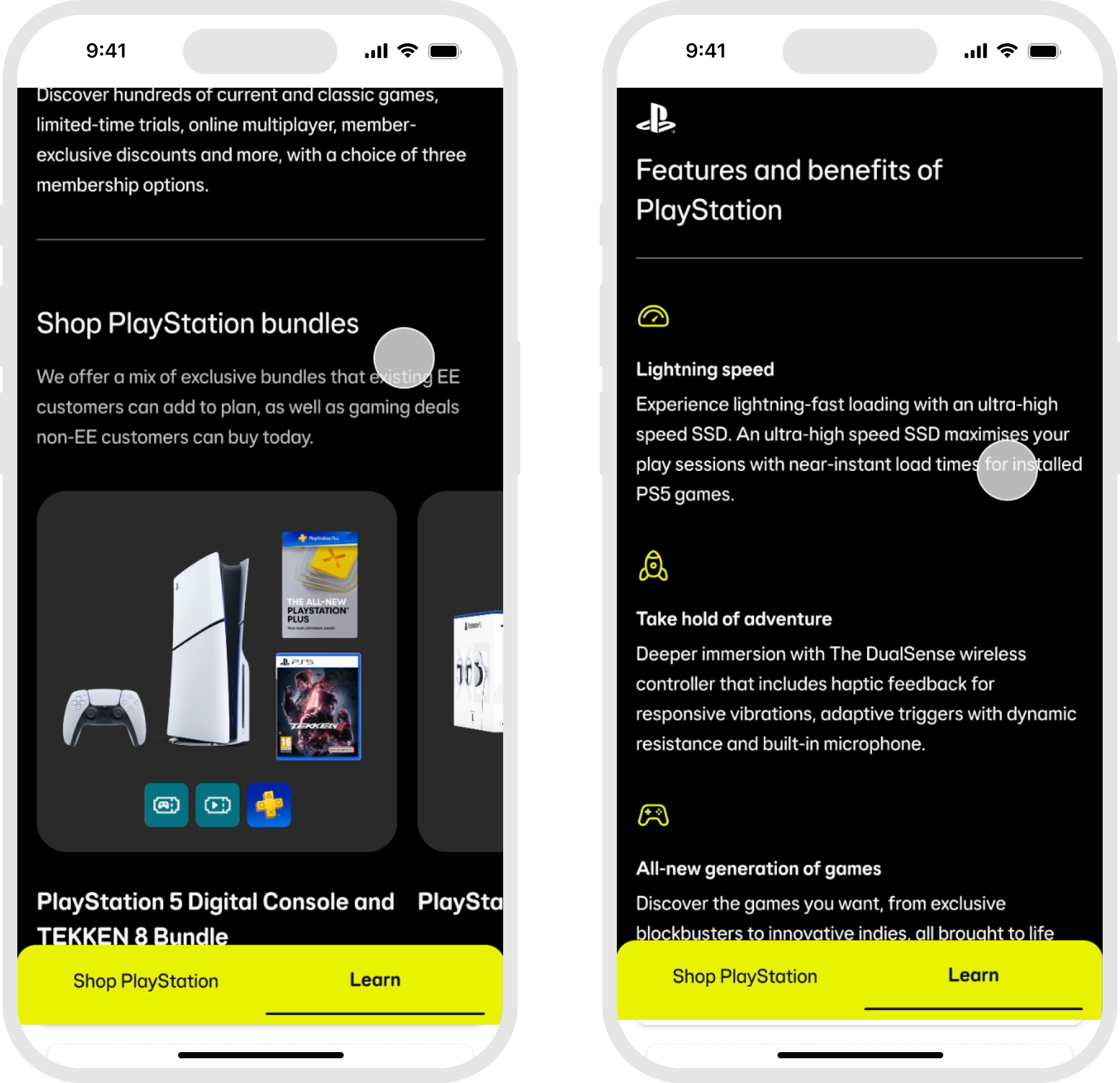
Impact
The launch of the v2 design marks a significant step forward in delivering a unified, inclusive gaming experience that supports both existing EE customers and new users across web and app.
By removing previous limitations and introducing a more flexible, user-centred design, we’ve improved accessibility, streamlined the purchase journey, and aligned the experience with the new EE brand. With the foundation now in place, we’ll continue to monitor performance, gather user feedback, and iterate regularly - ensuring the experience remains optimised, relevant, and responsive to customer needs as the gaming offering evolves.
Product Design
User Research
User Testing
EE enters the UK’s gaming market
Leading the design of EE’s multi-million-pound entry into the UK gaming market, positioning it as the go-to destination for gamers across all networks.

My role
Lead Product Designer
The team
-
Product Manager
-
User Researcher
-
Marketing
-
Accessibility Specialist
-
Content Designer
-
Brand
-
React (Web) and Flutter (App) Engineers
Background
Gaming is a key new vertical, forecast to generate £72m in revenue this year from both on
and off-net customers.
EE will sell gaming products such as consoles, games, accessories, monitors, PC parts and everything in between.
A brand campaign is planned for the 14th of July with messaging ‘EE Gaming available to
everybody’. Fundamental to this is the use of BT Shop to sell to customers who do not have an existing relationship with us. So this means there will be two websites, one for existing EE customers and one for non-EE customers.
The future plan for this is that these two stores merge, however to meet the deadline of the launch and with technical limitations, they must remeain separate.




Project goals
01
Propencity to call
We have only been briefed to introduce one new colour. However to make it more scalable and funtional we need tp
02
Unify the EE and BT gaming storefronts
The ask from brand was that this new colour should be used sparingly. It should only replace compnents that currentlt
03
Customer staisfaction
Ensure that existing EE customers benefit from personalised offers or account-linked features, while still allowing non-customers full access to the store and a frictionless purchase path.
04
Customer staisfaction
Design UX flows that reduce barriers to entry, such as unnecessary login prompts, while still enabling account benefits where relevant.
05
Customer staisfaction
Reflect the new, unified EE brand across all touchpoints in the journey, ensuring visual and experiential consistency during the EE and BT brand merge.
EE gaming landing page MVP
To support EE’s entry into the gaming market and begin validating customer interest, we launched a Minimum Viable Product (MVP) gaming store experience for existing EE customers.
This approach was driven by two key constraints: limited development resources and the capabilities of Adobe Experience Manager (AEM). With no dedicated development support available, we designed and built the page using only existing AEM components, ensuring we could go live quickly and within platform limitations.
Focusing the MVP on EE customers allowed us to:
-
Leverage existing account and billing integrations,
-
Operate within known customer journeys,
-
And start gathering early insights without requiring backend changes.
This pragmatic MVP approach enabled us to move fast, test core assumptions, and lay the foundation for a broader, unified experience that will eventually serve both EE and non-EE users as part of the merged brand strategy.

Journey mapping and competitor analysis
Existing and non-existing EE customer journey’s
Following the MVP launch, we conducted detailed journey mapping to understand the end-to-end experience for both existing EE customers and non-EE users. This work aimed to identify pain points, inconsistencies, and opportunities to create a more unified and inclusive gaming purchase journey.
For Existing EE Customers:
-
We mapped how customers discover, access, and navigate the gaming store through EE-owned channels.
-
Focus was placed on login flows, personalised offers, and device financing options linked to their account.
-
We identified areas where the experience is smooth (e.g. leveraging account info) and where it becomes fragmented or overly complex (e.g. unclear eligibility or gating).
For Non-Existing EE Customers:
-
We explored how non-customers currently interact with the BT gaming store or are blocked from accessing EE’s store.
-
Key friction points included gated access, inconsistent branding, and unclear messaging around who can buy and how.
-
The journey mapping highlighted the need for a more inclusive experience that allows all users to browse and purchase without feeling excluded.
These journey maps are now guiding design decisions for the future-state unified experience, ensuring that no matter who the user is or which channel they arrive from, they can easily explore and purchase gaming products with minimal friction.
Pain points (which are assumed as we have not run any user research for this journey):
-
Initial confusion once customers landed on the EE Gaming Hub and the rebranded BT shop page.
-
Overwhelming choice of products and services on the rebranded BT shop website.
-
A need for clearer CTAs for payment, log in and delivery options.
-
Eligibility of voucher codes.
-
Routes for customers to seek assistance for returns or other service issues.
Opportunities - Creating clear content:
-
To to help sign post users once they land on the EE Gaming Hub to the relevant next step.
-
To explain wider offering on the rebranded BT shop website.
-
For payment CTAs, delivery and log in options.
-
For help articles.
-
To encourage customers to complete their order if they've abandoned their basket, reframed as a wish list.

Gaming engagement programme overview






What do the main three gaming pages offer and what should they offer?
The gaming need state page is an educational page about the four main areas of EE: Work, Learn, Home and Gaming.
Iterating on the MVP design and user testing
After launching the MVP for EE customers, we began iterating on the design to prepare for user testing. The goal was to validate core assumptions, uncover usability issues, and understand how both EE and non-EE users interact with the experience.
Working within the existing AEM component limitations, we made lightweight design updates focused on:
-
Improving content clarity and hierarchy.
-
Enhancing navigation and product discovery.
-
And refining key moments like the add-to-basket and checkout flows.


Iterrating on
Participants: 4 x non-EE customers, 4 x EE customers, 2 x self identified gamers (remote and in person testing in labs
Key findings:
-
The yellow banner/ box did not draw the users attentions, the bundles did and users were very fixated on them.
-
In addition to not drawing the users attentions, some users informed us during the sessions that they simply ignored the yellow banner/ box even thought they saw it because they were drawn to the bundles.
-
Users noted the EE exclusive labels - however, it would not immediatelymake them interested in signing up to
have an EE account. They expected to
be EE mobile customers in order to get
those deals.
-
Users noted the EE exclusive labels - however, it would not immediatelymake them interested in signing up to
have an EE account. They expected to
be EE mobile customers in order to get
those deals.
-
Users noted the EE exclusive labels - however, it would not immediatelymake them interested in signing up to
have an EE account. They expected to
be EE mobile customers in order to get
those deals.
-
Users noted the EE exclusive labels - however, it would not immediatelymake them interested in signing up to
have an EE account. They expected to
be EE mobile customers in order to get
those deals.
-
Users noted the EE exclusive labels - however, it would not immediatelymake them interested in signing up to
have an EE account. They expected to
be EE mobile customers in order to get
those deals.
-
Users noted the EE exclusive labels - however, it would not immediatelymake them interested in signing up to
have an EE account. They expected to
be EE mobile customers in order to get
those deals.
Designing with dev resource
With dedicated development resource now available, we’re moving beyond the MVP constraints and can begin designing a more robust, scalable version of the gaming page for both web and app. This allows us to break free from the limitations of existing AEM components and introduce custom functionality, improved UI patterns, and a more refined user experience. We can now design with greater flexibility optimising layouts, enhancing performance, and ensuring consistency across platforms while aligning with the unified EE brand. This phase also enables deeper integration with account services, personalisation, and more advanced commerce capabilities.
For a deep dive into the user research conducted for this iteration click the button below:
Benchmarking user research

Going live V2 design
With dedicated development resource now available, we’re moving beyond the MVP constraints and can begin designing a more robust, scalable version of the gaming page for both web and app. This allows us to break free from the limitations of existing AEM components and introduce custom functionality, improved UI patterns, and a more refined user experience. We can now design with greater flexibility optimising layouts, enhancing performance, and ensuring consistency across platforms while aligning with the unified EE brand. This phase also enables deeper integration with account services, personalisation, and more advanced commerce capabilities.




Impact
The launch of the v2 design marks a significant step forward in delivering a unified, inclusive gaming experience that supports both existing EE customers and new users across web and app.
By removing previous limitations and introducing a more flexible, user-centred design, we’ve improved accessibility, streamlined the purchase journey, and aligned the experience with the new EE brand. With the foundation now in place, we’ll continue to monitor performance, gather user feedback, and iterate regularly - ensuring the experience remains optimised, relevant, and responsive to customer needs as the gaming offering evolves.
Product Design
User Research
User Testing
EE enters the UK’s gaming market
Leading the design of EE’s multi-million-pound entry into the UK gaming market, positioning it as the go-to destination for gamers across all networks.

My role
Lead Product Designer
The team
-
Product Manager
-
User Researcher
-
Marketing
-
Accessibility Specialist
-
Content Designer
-
Brand
-
React (Web) and Flutter (App) Engineers
Background
Gaming is a key new vertical, forecast to generate £72m in revenue this year from both on
and off-net customers.
EE will sell gaming products such as consoles, games, accessories, monitors, PC parts and everything in between.
A brand campaign is planned for the 14th of July with messaging ‘EE Gaming available to
everybody’. Fundamental to this is the use of BT Shop to sell to customers who do not have an existing relationship with us. So this means there will be two websites, one for existing EE customers and one for non-EE customers.
The future plan for this is that these two stores merge, however to meet the deadline of the launch and with technical limitations, they must remeain separate.




Project goals
01
Propencity to call
We have only been briefed to introduce one new colour. However to make it more scalable and funtional we need tp
02
Unify the EE and BT gaming storefronts
The ask from brand was that this new colour should be used sparingly. It should only replace compnents that currentlt
03
Customer staisfaction
Ensure that existing EE customers benefit from personalised offers or account-linked features, while still allowing non-customers full access to the store and a frictionless purchase path.
04
Customer staisfaction
Design UX flows that reduce barriers to entry, such as unnecessary login prompts, while still enabling account benefits where relevant.
05
Customer staisfaction
Reflect the new, unified EE brand across all touchpoints in the journey, ensuring visual and experiential consistency during the EE and BT brand merge.
EE gaming landing page MVP
To support EE’s entry into the gaming market and begin validating customer interest, we launched a Minimum Viable Product (MVP) gaming store experience for existing EE customers.
This approach was driven by two key constraints: limited development resources and the capabilities of Adobe Experience Manager (AEM). With no dedicated development support available, we designed and built the page using only existing AEM components, ensuring we could go live quickly and within platform limitations.
Focusing the MVP on EE customers allowed us to:
-
Leverage existing account and billing integrations,
-
Operate within known customer journeys,
-
And start gathering early insights without requiring backend changes.
This pragmatic MVP approach enabled us to move fast, test core assumptions, and lay the foundation for a broader, unified experience that will eventually serve both EE and non-EE users as part of the merged brand strategy.

Journey mapping and competitor analysis
Existing and non-existing EE customer journey’s
Following the MVP launch, we conducted detailed journey mapping to understand the end-to-end experience for both existing EE customers and non-EE users. This work aimed to identify pain points, inconsistencies, and opportunities to create a more unified and inclusive gaming purchase journey.
For Existing EE Customers:
-
We mapped how customers discover, access, and navigate the gaming store through EE-owned channels.
-
Focus was placed on login flows, personalised offers, and device financing options linked to their account.
-
We identified areas where the experience is smooth (e.g. leveraging account info) and where it becomes fragmented or overly complex (e.g. unclear eligibility or gating).
For Non-Existing EE Customers:
-
We explored how non-customers currently interact with the BT gaming store or are blocked from accessing EE’s store.
-
Key friction points included gated access, inconsistent branding, and unclear messaging around who can buy and how.
-
The journey mapping highlighted the need for a more inclusive experience that allows all users to browse and purchase without feeling excluded.
These journey maps are now guiding design decisions for the future-state unified experience, ensuring that no matter who the user is or which channel they arrive from, they can easily explore and purchase gaming products with minimal friction.
Pain points (which are assumed as we have not run any user research for this journey):
-
Initial confusion once customers landed on the EE Gaming Hub and the rebranded BT shop page.
-
Overwhelming choice of products and services on the rebranded BT shop website.
-
A need for clearer CTAs for payment, log in and delivery options.
-
Eligibility of voucher codes.
-
Routes for customers to seek assistance for returns or other service issues.
Opportunities - Creating clear content:
-
To to help sign post users once they land on the EE Gaming Hub to the relevant next step.
-
To explain wider offering on the rebranded BT shop website.
-
For payment CTAs, delivery and log in options.
-
For help articles.
-
To encourage customers to complete their order if they've abandoned their basket, reframed as a wish list.

Gaming engagement programme overview






What do the main three gaming pages offer and what should they offer?
The gaming need state page is an educational page about the four main areas of EE: Work, Learn, Home and Gaming.
Iterating on the MVP design and user testing
After launching the MVP for EE customers, we began iterating on the design to prepare for user testing. The goal was to validate core assumptions, uncover usability issues, and understand how both EE and non-EE users interact with the experience.
Working within the existing AEM component limitations, we made lightweight design updates focused on:
-
Improving content clarity and hierarchy.
-
Enhancing navigation and product discovery.
-
And refining key moments like the add-to-basket and checkout flows.


Iterrating on
Participants: 4 x non-EE customers, 4 x EE customers, 2 x self identified gamers (remote and in person testing in labs
Key findings:
-
The yellow banner/ box did not draw the users attentions, the bundles did and users were very fixated on them.
-
In addition to not drawing the users attentions, some users informed us during the sessions that they simply ignored the yellow banner/ box even thought they saw it because they were drawn to the bundles.
-
Users noted the EE exclusive labels - however, it would not immediatelymake them interested in signing up to
have an EE account. They expected to
be EE mobile customers in order to get
those deals.
-
Users noted the EE exclusive labels - however, it would not immediatelymake them interested in signing up to
have an EE account. They expected to
be EE mobile customers in order to get
those deals.
-
Users noted the EE exclusive labels - however, it would not immediatelymake them interested in signing up to
have an EE account. They expected to
be EE mobile customers in order to get
those deals.
-
Users noted the EE exclusive labels - however, it would not immediatelymake them interested in signing up to
have an EE account. They expected to
be EE mobile customers in order to get
those deals.
-
Users noted the EE exclusive labels - however, it would not immediatelymake them interested in signing up to
have an EE account. They expected to
be EE mobile customers in order to get
those deals.
-
Users noted the EE exclusive labels - however, it would not immediatelymake them interested in signing up to
have an EE account. They expected to
be EE mobile customers in order to get
those deals.
Designing with dev resource
With dedicated development resource now available, we’re moving beyond the MVP constraints and can begin designing a more robust, scalable version of the gaming page for both web and app. This allows us to break free from the limitations of existing AEM components and introduce custom functionality, improved UI patterns, and a more refined user experience. We can now design with greater flexibility optimising layouts, enhancing performance, and ensuring consistency across platforms while aligning with the unified EE brand. This phase also enables deeper integration with account services, personalisation, and more advanced commerce capabilities.
For a deep dive into the user research conducted for this iteration click the button below:
Benchmarking user research

Going live V2 design
With dedicated development resource now available, we’re moving beyond the MVP constraints and can begin designing a more robust, scalable version of the gaming page for both web and app. This allows us to break free from the limitations of existing AEM components and introduce custom functionality, improved UI patterns, and a more refined user experience. We can now design with greater flexibility optimising layouts, enhancing performance, and ensuring consistency across platforms while aligning with the unified EE brand. This phase also enables deeper integration with account services, personalisation, and more advanced commerce capabilities.




Impact
The launch of the v2 design marks a significant step forward in delivering a unified, inclusive gaming experience that supports both existing EE customers and new users across web and app.
By removing previous limitations and introducing a more flexible, user-centred design, we’ve improved accessibility, streamlined the purchase journey, and aligned the experience with the new EE brand. With the foundation now in place, we’ll continue to monitor performance, gather user feedback, and iterate regularly - ensuring the experience remains optimised, relevant, and responsive to customer needs as the gaming offering evolves.
Product Design
User Research
User Testing
EE enters the UK’s gaming market
Leading the design of EE’s multi-million-pound entry into the UK gaming market, positioning it as the go-to destination for gamers across all networks.

My role
Lead Product Designer
The team
-
Product Manager
-
User Researcher
-
Marketing
-
Accessibility Specialist
-
Content Designer
-
Brand
-
React (Web) and Flutter (App) Engineers
Background
Gaming is a key new vertical, forecast to generate £72m in revenue this year from both on
and off-net customers.
EE will sell gaming products such as consoles, games, accessories, monitors, PC parts and everything in between.
A brand campaign is planned for the 14th of July with messaging ‘EE Gaming available to
everybody’. Fundamental to this is the use of BT Shop to sell to customers who do not have an existing relationship with us. So this means there will be two websites, one for existing EE customers and one for non-EE customers.
The future plan for this is that these two stores merge, however to meet the deadline of the launch and with technical limitations, they must remeain separate.




Project goals
01
Propencity to call
We have only been briefed to introduce one new colour. However to make it more scalable and funtional we need tp
02
Unify the EE and BT gaming storefronts
The ask from brand was that this new colour should be used sparingly. It should only replace compnents that currentlt
03
Customer staisfaction
Ensure that existing EE customers benefit from personalised offers or account-linked features, while still allowing non-customers full access to the store and a frictionless purchase path.
04
Customer staisfaction
Design UX flows that reduce barriers to entry, such as unnecessary login prompts, while still enabling account benefits where relevant.
05
Customer staisfaction
Reflect the new, unified EE brand across all touchpoints in the journey, ensuring visual and experiential consistency during the EE and BT brand merge.
EE gaming landing page MVP
To support EE’s entry into the gaming market and begin validating customer interest, we launched a Minimum Viable Product (MVP) gaming store experience for existing EE customers.
This approach was driven by two key constraints: limited development resources and the capabilities of Adobe Experience Manager (AEM). With no dedicated development support available, we designed and built the page using only existing AEM components, ensuring we could go live quickly and within platform limitations.
Focusing the MVP on EE customers allowed us to:
-
Leverage existing account and billing integrations,
-
Operate within known customer journeys,
-
And start gathering early insights without requiring backend changes.
This pragmatic MVP approach enabled us to move fast, test core assumptions, and lay the foundation for a broader, unified experience that will eventually serve both EE and non-EE users as part of the merged brand strategy.

Journey mapping and competitor analysis
Existing and non-existing EE customer journey’s
Following the MVP launch, we conducted detailed journey mapping to understand the end-to-end experience for both existing EE customers and non-EE users. This work aimed to identify pain points, inconsistencies, and opportunities to create a more unified and inclusive gaming purchase journey.
For Existing EE Customers:
-
We mapped how customers discover, access, and navigate the gaming store through EE-owned channels.
-
Focus was placed on login flows, personalised offers, and device financing options linked to their account.
-
We identified areas where the experience is smooth (e.g. leveraging account info) and where it becomes fragmented or overly complex (e.g. unclear eligibility or gating).
For Non-Existing EE Customers:
-
We explored how non-customers currently interact with the BT gaming store or are blocked from accessing EE’s store.
-
Key friction points included gated access, inconsistent branding, and unclear messaging around who can buy and how.
-
The journey mapping highlighted the need for a more inclusive experience that allows all users to browse and purchase without feeling excluded.
These journey maps are now guiding design decisions for the future-state unified experience, ensuring that no matter who the user is or which channel they arrive from, they can easily explore and purchase gaming products with minimal friction.
Pain points (which are assumed as we have not run any user research for this journey):
-
Initial confusion once customers landed on the EE Gaming Hub and the rebranded BT shop page.
-
Overwhelming choice of products and services on the rebranded BT shop website.
-
A need for clearer CTAs for payment, log in and delivery options.
-
Eligibility of voucher codes.
-
Routes for customers to seek assistance for returns or other service issues.
Opportunities - Creating clear content:
-
To to help sign post users once they land on the EE Gaming Hub to the relevant next step.
-
To explain wider offering on the rebranded BT shop website.
-
For payment CTAs, delivery and log in options.
-
For help articles.
-
To encourage customers to complete their order if they've abandoned their basket, reframed as a wish list.

Gaming engagement programme overview






What do the main three gaming pages offer and what should they offer?
The gaming need state page is an educational page about the four main areas of EE: Work, Learn, Home and Gaming.
Iterating on the MVP design and user testing
After launching the MVP for EE customers, we began iterating on the design to prepare for user testing. The goal was to validate core assumptions, uncover usability issues, and understand how both EE and non-EE users interact with the experience.
Working within the existing AEM component limitations, we made lightweight design updates focused on:
-
Improving content clarity and hierarchy.
-
Enhancing navigation and product discovery.
-
And refining key moments like the add-to-basket and checkout flows.


Iterrating on
Participants: 4 x non-EE customers, 4 x EE customers, 2 x self identified gamers (remote and in person testing in labs
Key findings:
-
The yellow banner/ box did not draw the users attentions, the bundles did and users were very fixated on them.
-
In addition to not drawing the users attentions, some users informed us during the sessions that they simply ignored the yellow banner/ box even thought they saw it because they were drawn to the bundles.
-
Users noted the EE exclusive labels - however, it would not immediatelymake them interested in signing up to
have an EE account. They expected to
be EE mobile customers in order to get
those deals.
-
Users noted the EE exclusive labels - however, it would not immediatelymake them interested in signing up to
have an EE account. They expected to
be EE mobile customers in order to get
those deals.
-
Users noted the EE exclusive labels - however, it would not immediatelymake them interested in signing up to
have an EE account. They expected to
be EE mobile customers in order to get
those deals.
-
Users noted the EE exclusive labels - however, it would not immediatelymake them interested in signing up to
have an EE account. They expected to
be EE mobile customers in order to get
those deals.
-
Users noted the EE exclusive labels - however, it would not immediatelymake them interested in signing up to
have an EE account. They expected to
be EE mobile customers in order to get
those deals.
-
Users noted the EE exclusive labels - however, it would not immediatelymake them interested in signing up to
have an EE account. They expected to
be EE mobile customers in order to get
those deals.
Designing with dev resource
With dedicated development resource now available, we’re moving beyond the MVP constraints and can begin designing a more robust, scalable version of the gaming page for both web and app. This allows us to break free from the limitations of existing AEM components and introduce custom functionality, improved UI patterns, and a more refined user experience. We can now design with greater flexibility optimising layouts, enhancing performance, and ensuring consistency across platforms while aligning with the unified EE brand. This phase also enables deeper integration with account services, personalisation, and more advanced commerce capabilities.
For a deep dive into the user research conducted for this iteration click the button below:
Benchmarking user research

Going live V2 design
With dedicated development resource now available, we’re moving beyond the MVP constraints and can begin designing a more robust, scalable version of the gaming page for both web and app. This allows us to break free from the limitations of existing AEM components and introduce custom functionality, improved UI patterns, and a more refined user experience. We can now design with greater flexibility optimising layouts, enhancing performance, and ensuring consistency across platforms while aligning with the unified EE brand. This phase also enables deeper integration with account services, personalisation, and more advanced commerce capabilities.




Impact
The launch of the v2 design marks a significant step forward in delivering a unified, inclusive gaming experience that supports both existing EE customers and new users across web and app.
By removing previous limitations and introducing a more flexible, user-centred design, we’ve improved accessibility, streamlined the purchase journey, and aligned the experience with the new EE brand. With the foundation now in place, we’ll continue to monitor performance, gather user feedback, and iterate regularly - ensuring the experience remains optimised, relevant, and responsive to customer needs as the gaming offering evolves.
Product Design
User Research
User Testing
EE enters the UK’s gaming market
Leading the design of EE’s multi-million-pound entry into the UK gaming market, positioning it as the go-to destination for gamers across all networks.

My role
Lead Product Designer
The team
-
Product Manager
-
User Researcher
-
Marketing
-
Accessibility Specialist
-
Content Designer
-
Brand
-
React (Web) and Flutter (App) Engineers
Background
Gaming is a major new focus for EE, projected to generate £72m in revenue this year from both on- and off-net customers.
A brand campaign launches on 14th July with the message: "EE Gaming available to everybody." Central to this is using BT Shop to reach non-EE customers.
As EE transforms into a broader consumer tech brand, it’s unifying its and BT’s fragmented gaming offerings into a single, inclusive store. This new platform will serve all users with products, subscriptions, and flexible payments - backed by EE’s network and BT’s connectivity heritage.
This move reinforces EE’s ambition to lead in digital entertainment and become the UK’s most personal tech brand.




Project goals
01
Create a seamless customer journey for all users
Design and deliver intuitive shopping journeys that allow both existing EE customers and non-EE users to browse and purchase gaming products - regardless of their starting point or login status. These journey’s must be kept separate from each other (for now) as the phase out of the BT Store (soon to be rebranded to EE Store) will span a couple of years.
02
Unify the EE and BT gaming storefronts
Consolidate the current EE (customer-only) and BT (non-customer) gaming stores into a single, consistent destination that reflects the new, merged EE brand identity.
03
Design for personalisation without exclusion
Ensure that existing EE customers benefit from personalised offers or account-linked features, while still allowing non-customers full access to the store and a frictionless purchase path.
04
Minimise purchase friction across user types
Design UX flows that reduce barriers to entry, such as unnecessary login prompts, while still enabling account benefits where relevant.
05
Support brand transition objectives
Reflect the new, unified EE brand across all touchpoints in the journey, ensuring visual and experiential consistency during the EE and BT brand merge.
EE gaming landing page MVP
To support EE’s entry into the gaming market and begin validating customer interest, we launched a Minimum Viable Product (MVP) gaming store experience for existing EE customers.
This approach was driven by two key constraints: limited development resources and the capabilities of Adobe Experience Manager (AEM). With no dedicated development support available, we designed and built the page using only existing AEM components, ensuring we could go live quickly and within platform limitations.
Focusing the MVP on EE customers allowed us to:
-
Leverage existing account and billing integrations,
-
Operate within known customer journeys,
-
And start gathering early insights without requiring backend changes.
This pragmatic MVP approach enabled us to move fast, test core assumptions, and lay the foundation for a broader, unified experience that will eventually serve both EE and non-EE users as part of the merged brand strategy.

Journey mapping and competitor analysis
Existing and non-existing EE customer journey’s
Following the MVP launch, we conducted detailed journey mapping to understand the end-to-end experience for both existing EE customers and non-EE users. This work aimed to identify pain points, inconsistencies, and opportunities to create a more unified and inclusive gaming purchase journey.
For Existing EE Customers:
-
We mapped how customers discover, access, and navigate the gaming store through EE-owned channels.
-
Focus was placed on login flows, personalised offers, and device financing options linked to their account.
-
We identified areas where the experience is smooth (e.g. leveraging account info) and where it becomes fragmented or overly complex (e.g. unclear eligibility or gating).
For Non-Existing EE Customers:
-
We explored how non-customers currently interact with the BT gaming store or are blocked from accessing EE’s store.
-
Key friction points included gated access, inconsistent branding, and unclear messaging around who can buy and how.
-
The journey mapping highlighted the need for a more inclusive experience that allows all users to browse and purchase without feeling excluded.
These journey maps are now guiding design decisions for the future-state unified experience, ensuring that no matter who the user is or which channel they arrive from, they can easily explore and purchase gaming products with minimal friction.
Pain points (which are assumed as we have not run any user research for this journey):
-
Initial confusion once customers landed on the EE Gaming Hub and the rebranded BT shop page.
-
Overwhelming choice of products and services on the rebranded BT shop website.
-
A need for clearer CTAs for payment, log in and delivery options.
-
Eligibility of voucher codes.
-
Routes for customers to seek assistance for returns or other service issues.
Opportunities - Creating clear content:
-
To to help sign post users once they land on the EE Gaming Hub to the relevant next step.
-
To explain wider offering on the rebranded BT shop website.
-
For payment CTAs, delivery and log in options.
-
For help articles.
-
To encourage customers to complete their order if they've abandoned their basket, reframed as a wish list.

Gaming engagement programme overview






What do the main three gaming pages offer and what should they offer?
The gaming need state page is an educational page about the four main areas of EE: Work, Learn, Home and Gaming.
Iterating on the MVP design and user testing
After launching the MVP for EE customers, we began iterating on the design to prepare for user testing. The goal was to validate core assumptions, uncover usability issues, and understand how both EE and non-EE users interact with the experience.
Working within the existing AEM component limitations, we made lightweight design updates focused on:
-
Improving content clarity and hierarchy.
-
Enhancing navigation and product discovery.
-
And refining key moments like the add-to-basket and checkout flows.


User research findings
Participants: 4 x non-EE customers, 4 x EE customers, 2 x self identified gamers (remote and in person testing in labs
Key findings:
-
The yellow banner/ box did not draw the users attentions, the bundles did and users were very fixated on them.
-
In addition to not drawing the users attentions, some users informed us during the sessions that they simply ignored the yellow banner/ box even thought they saw it because they were drawn to the bundles.
-
Users noted the EE exclusive labels - however, it would not immediately make them interested in signing up to have an EE account. They expected to be EE mobile customers in order to get those deals.
-
Users did not expect to be able to make game purchases on BT/ EE store, this is to do with their perception that EE is for mobile only.
-
When asked how they would go about buying a copy of Call of Duty, users immediately went to search.
-
Users noticed the difference between the two store fronts, commented that the EE one looked better visually.
-
PayPal is a welcome payment option.
-
Users expected to be able to use guest checkout to make one-off purchases.
Designing with dev resource
With dedicated development resource now available, we’re moving beyond the MVP constraints and can begin designing a more robust, scalable version of the gaming page for both web and app. This allows us to break free from the limitations of existing AEM components and introduce custom functionality, improved UI patterns, and a more refined user experience. We can now design with greater flexibility optimising layouts, enhancing performance, and ensuring consistency across platforms while aligning with the unified EE brand. This phase also enables deeper integration with account services, personalisation, and more advanced commerce capabilities.
For a deep dive into the user research conducted for this iteration click the button below:
Benchmarking user research

Going live V2 design
With dedicated development resource now available, we’re moving beyond the MVP constraints and can begin designing a more robust, scalable version of the gaming page for both web and app. This allows us to break free from the limitations of existing AEM components and introduce custom functionality, improved UI patterns, and a more refined user experience. We can now design with greater flexibility optimising layouts, enhancing performance, and ensuring consistency across platforms while aligning with the unified EE brand. This phase also enables deeper integration with account services, personalisation, and more advanced commerce capabilities.




Impact
The launch of the v2 design marks a significant step forward in delivering a unified, inclusive gaming experience that supports both existing EE customers and new users across web and app.
By removing previous limitations and introducing a more flexible, user-centred design, we’ve improved accessibility, streamlined the purchase journey, and aligned the experience with the new EE brand. With the foundation now in place, we’ll continue to monitor performance, gather user feedback, and iterate regularly - ensuring the experience remains optimised, relevant, and responsive to customer needs as the gaming offering evolves.
